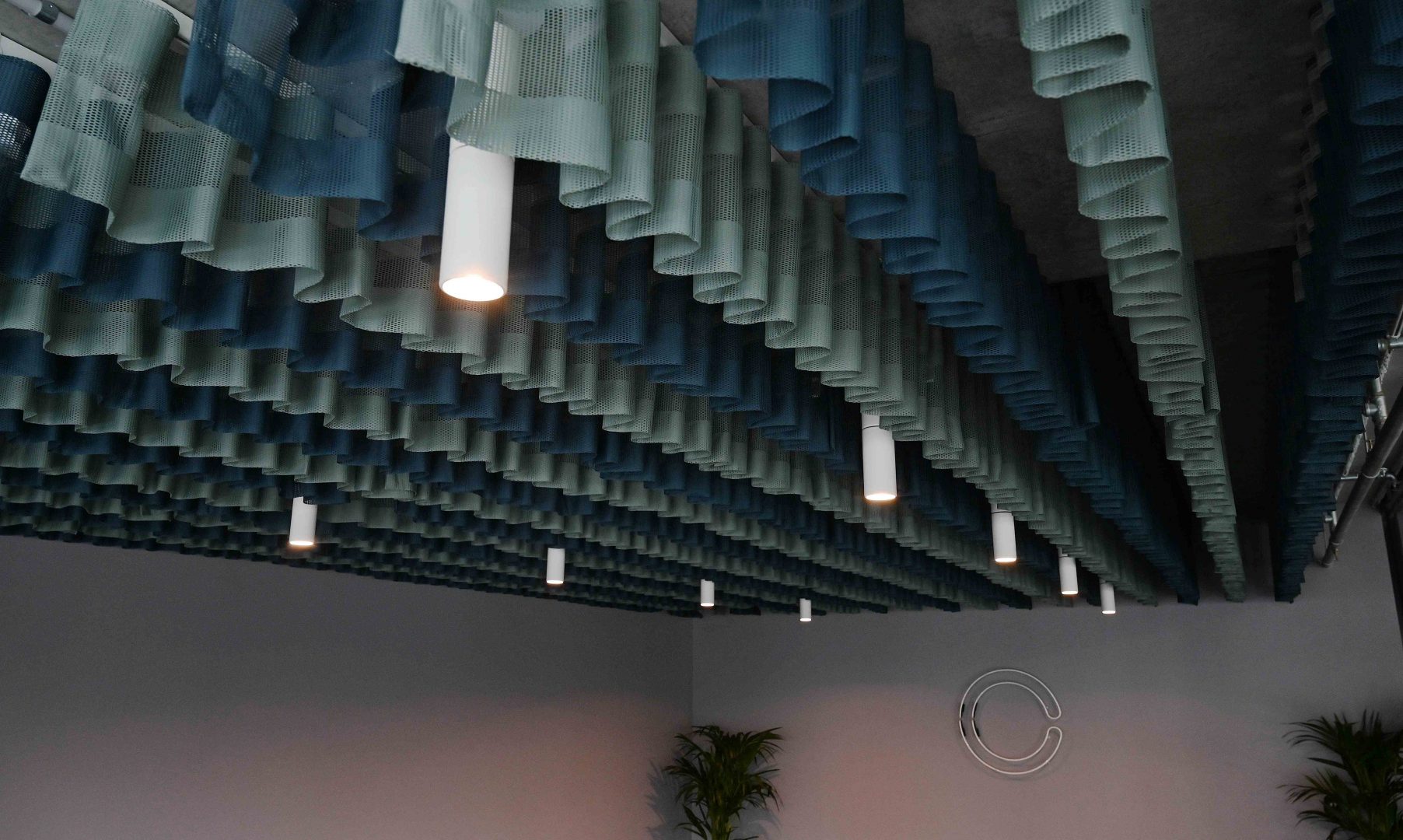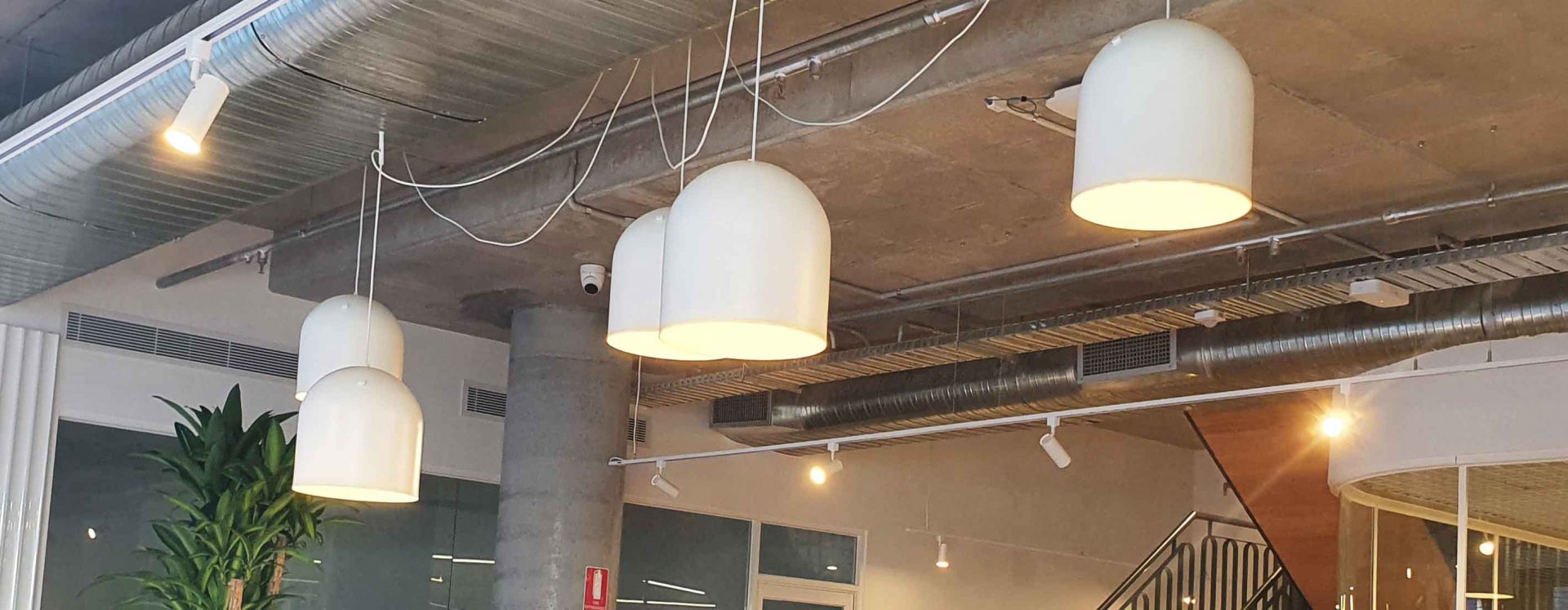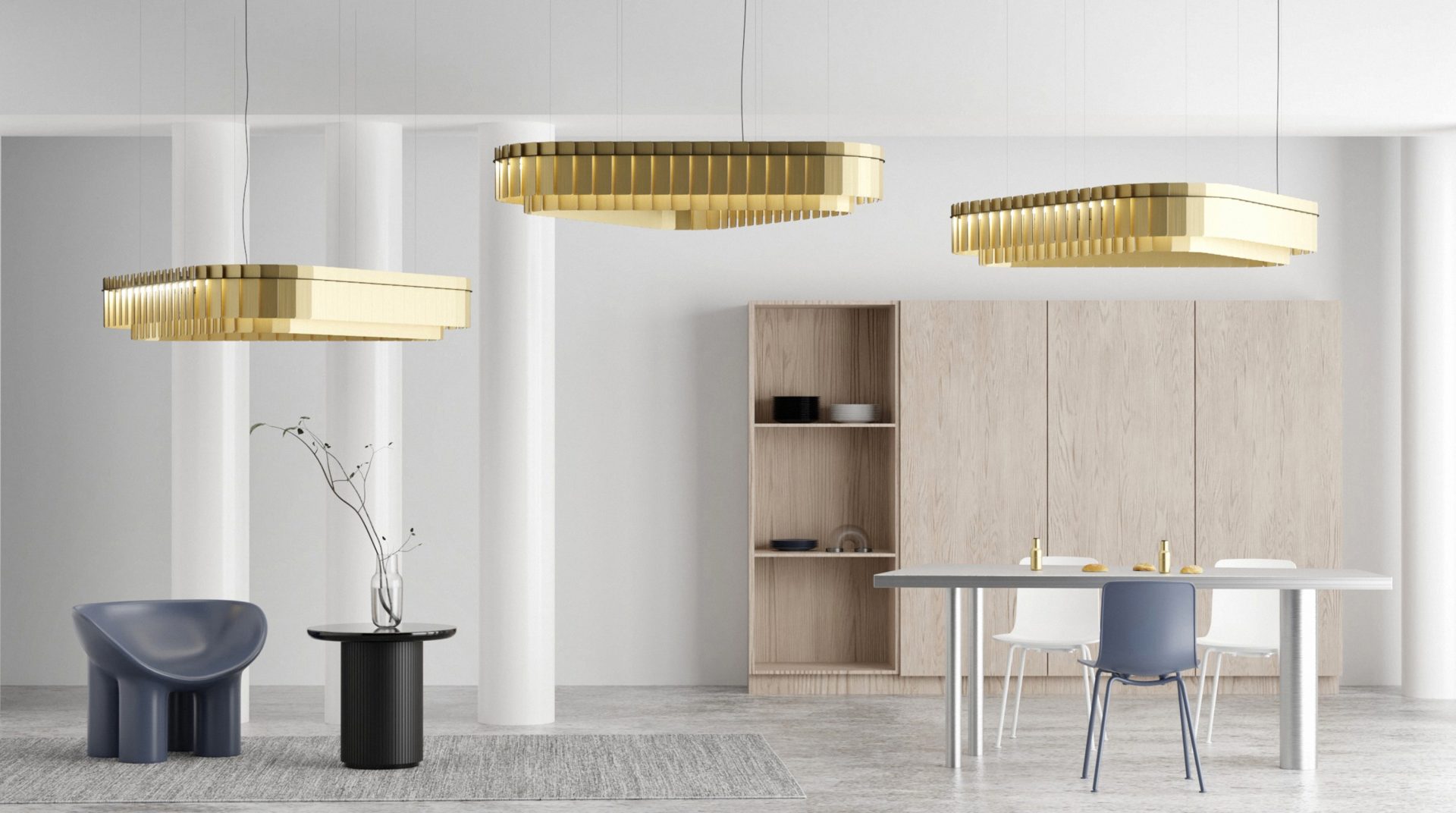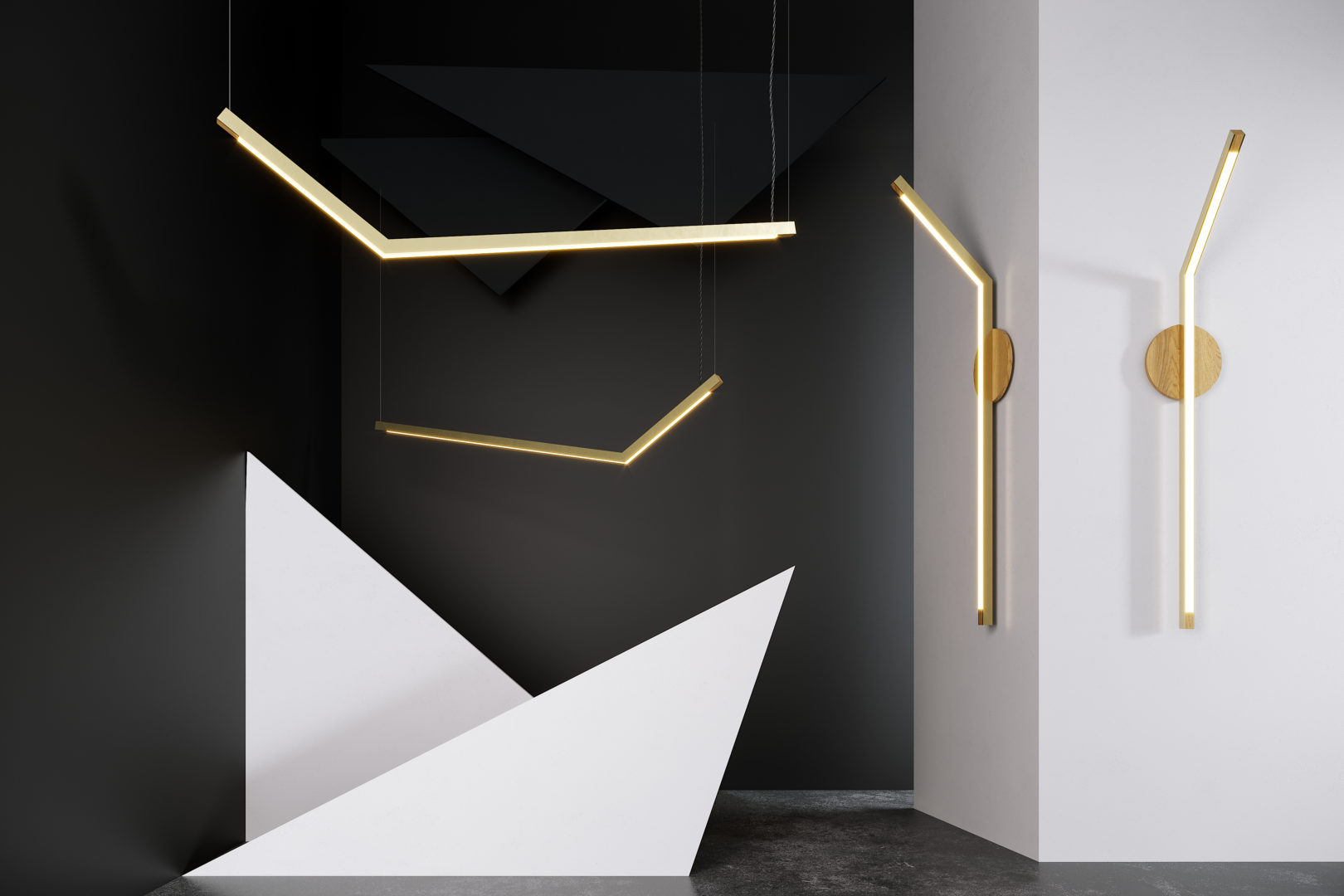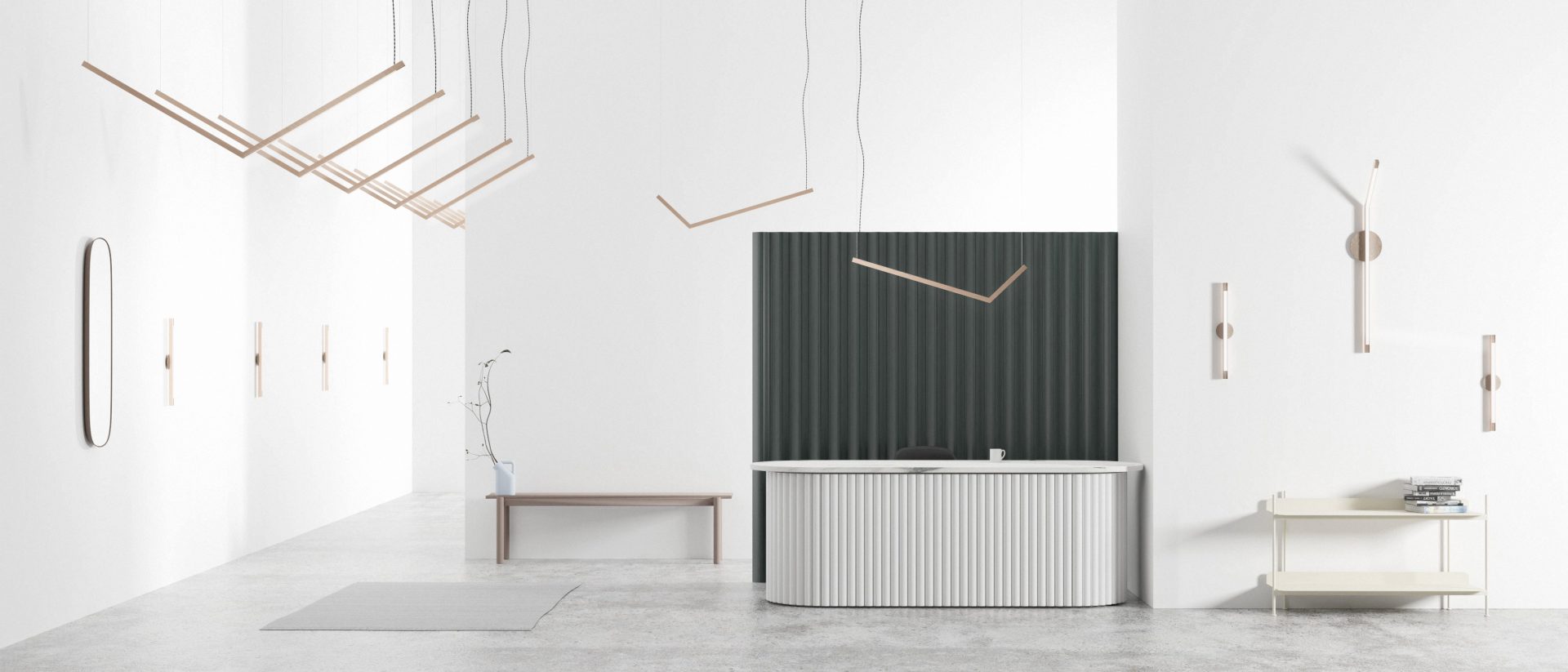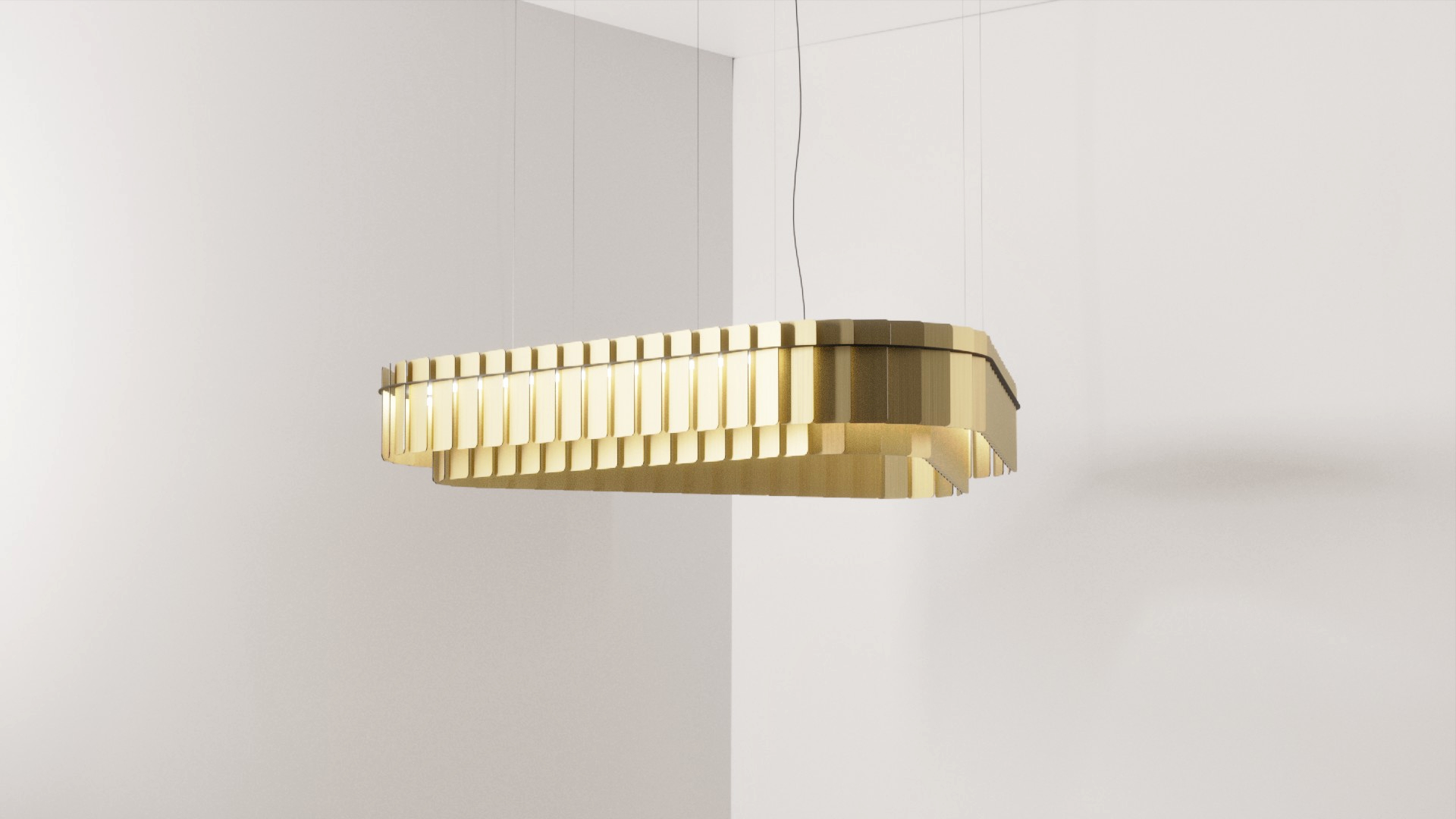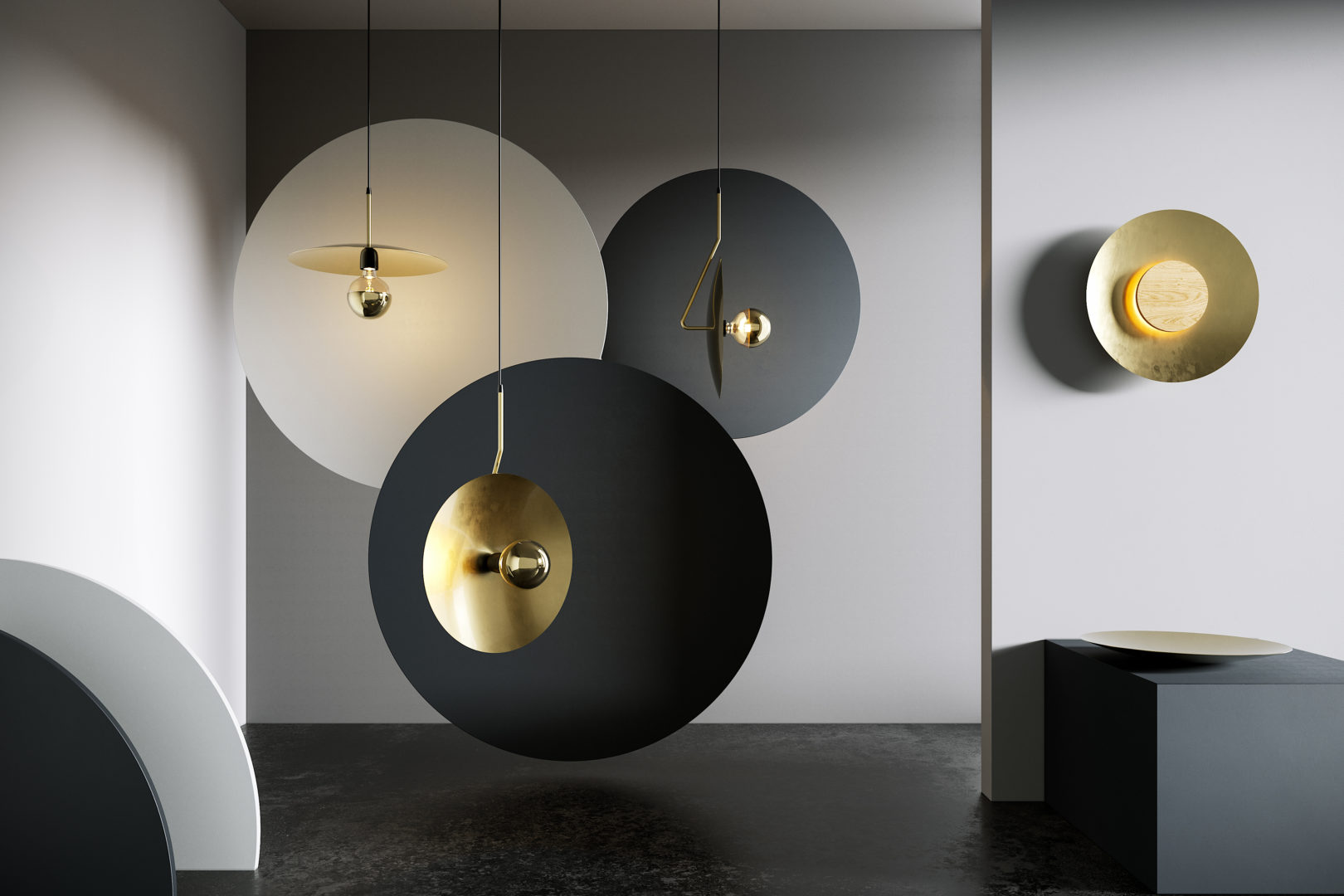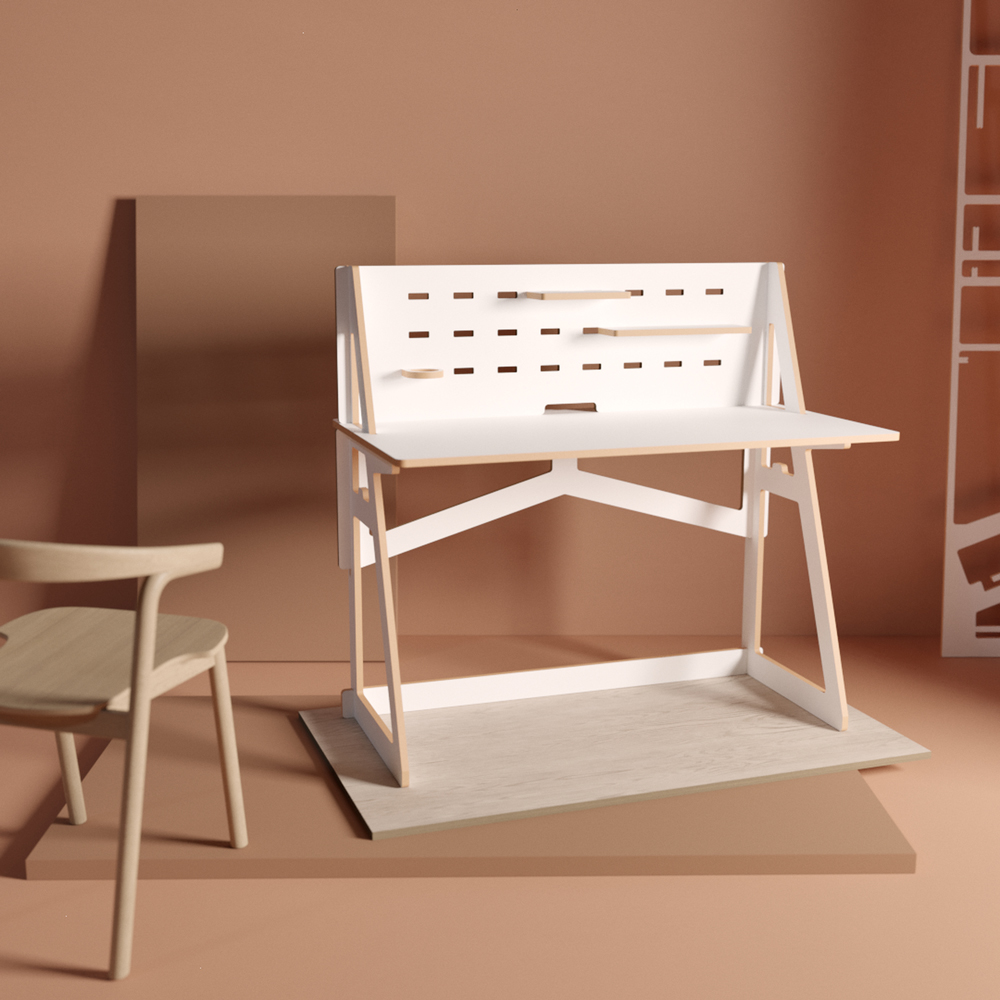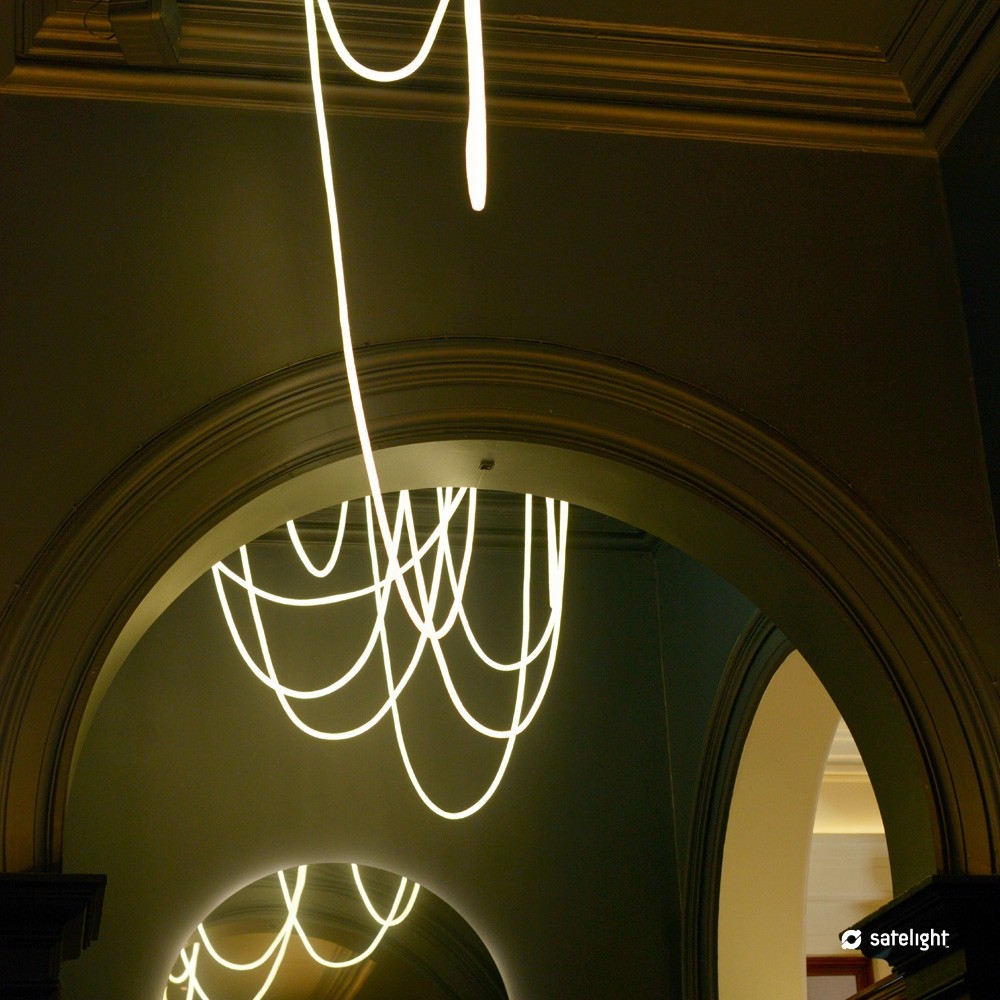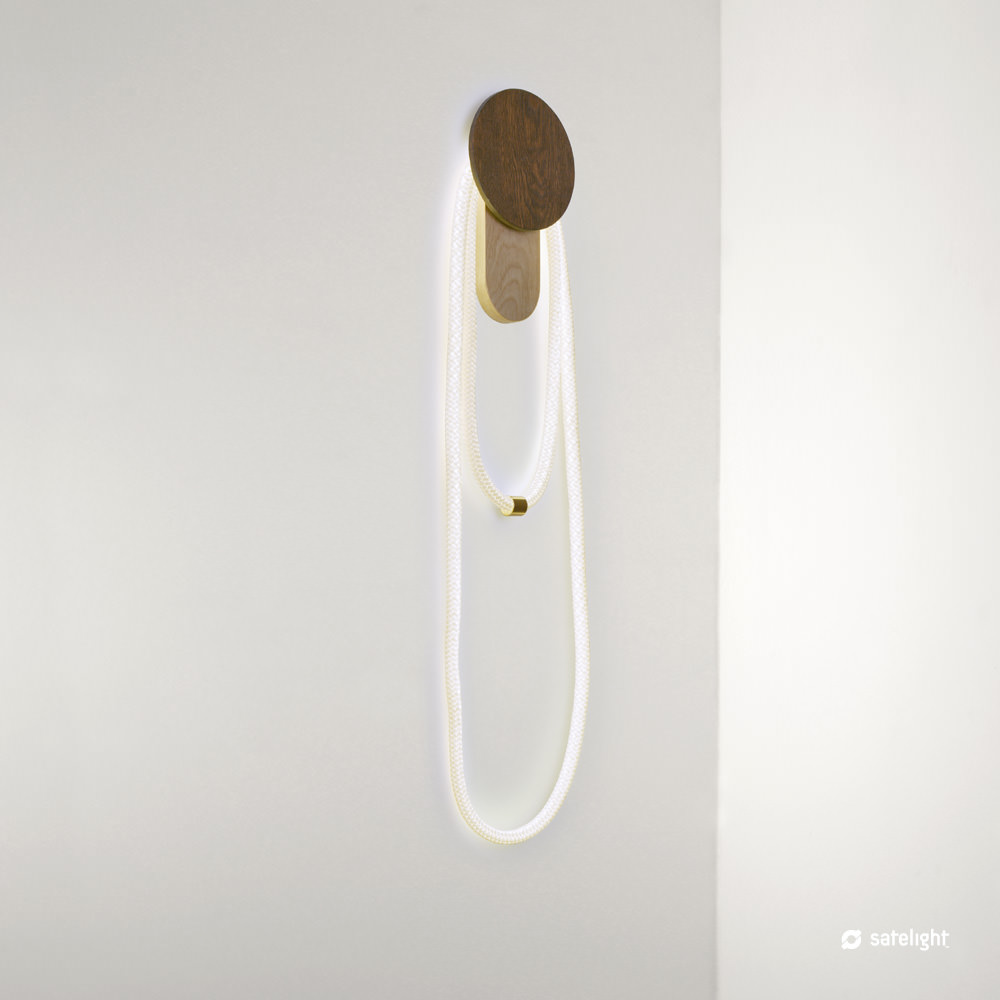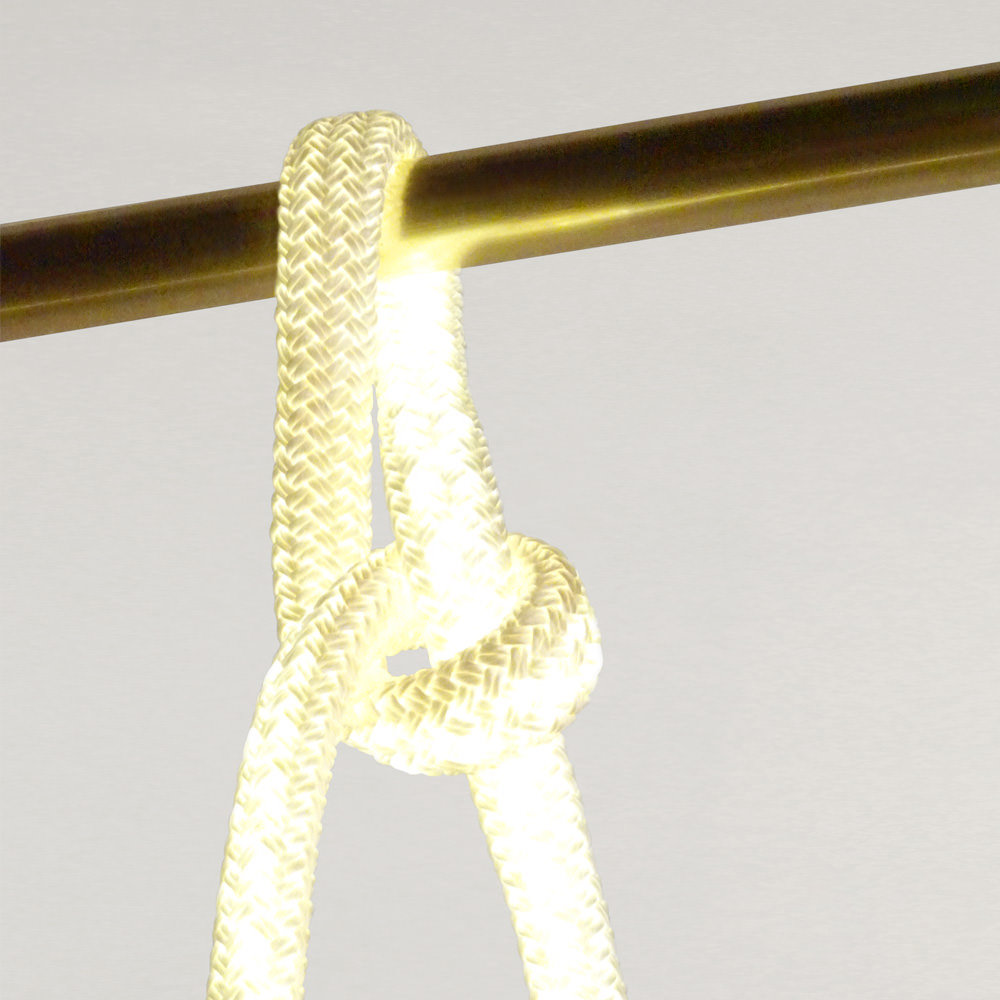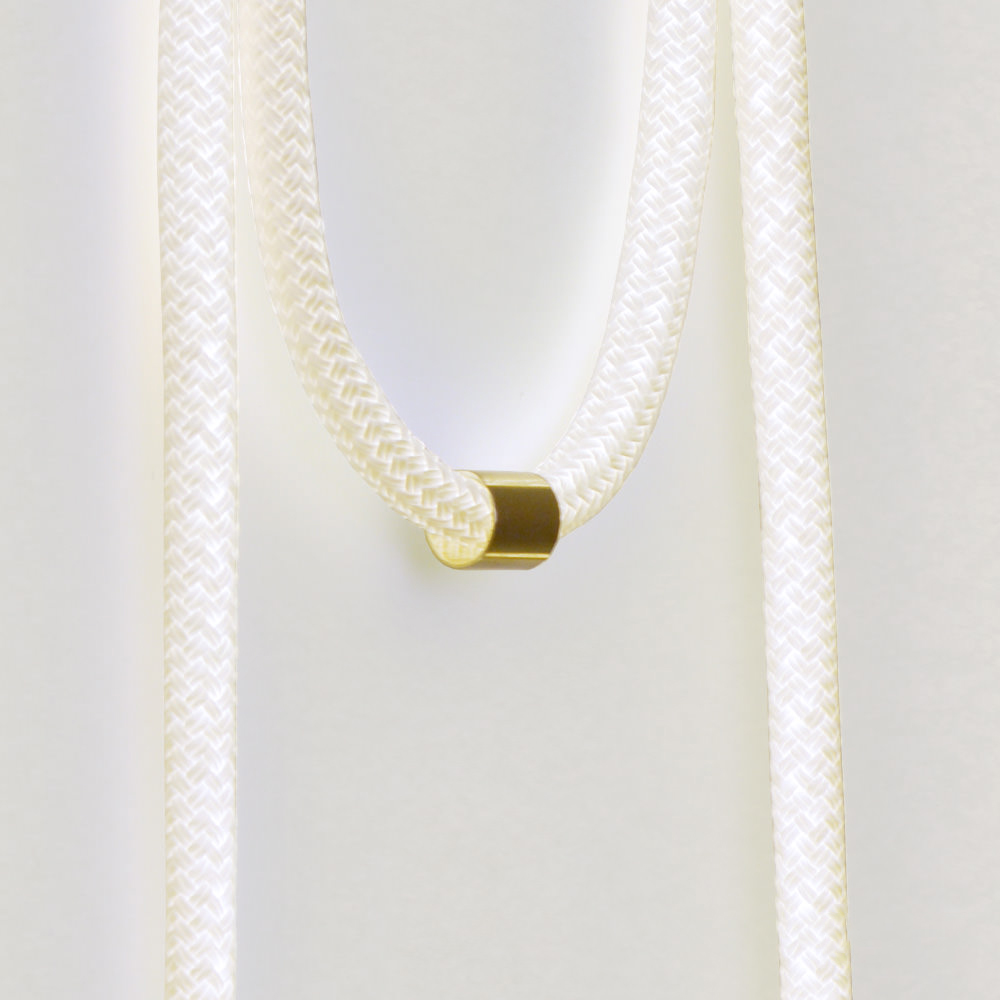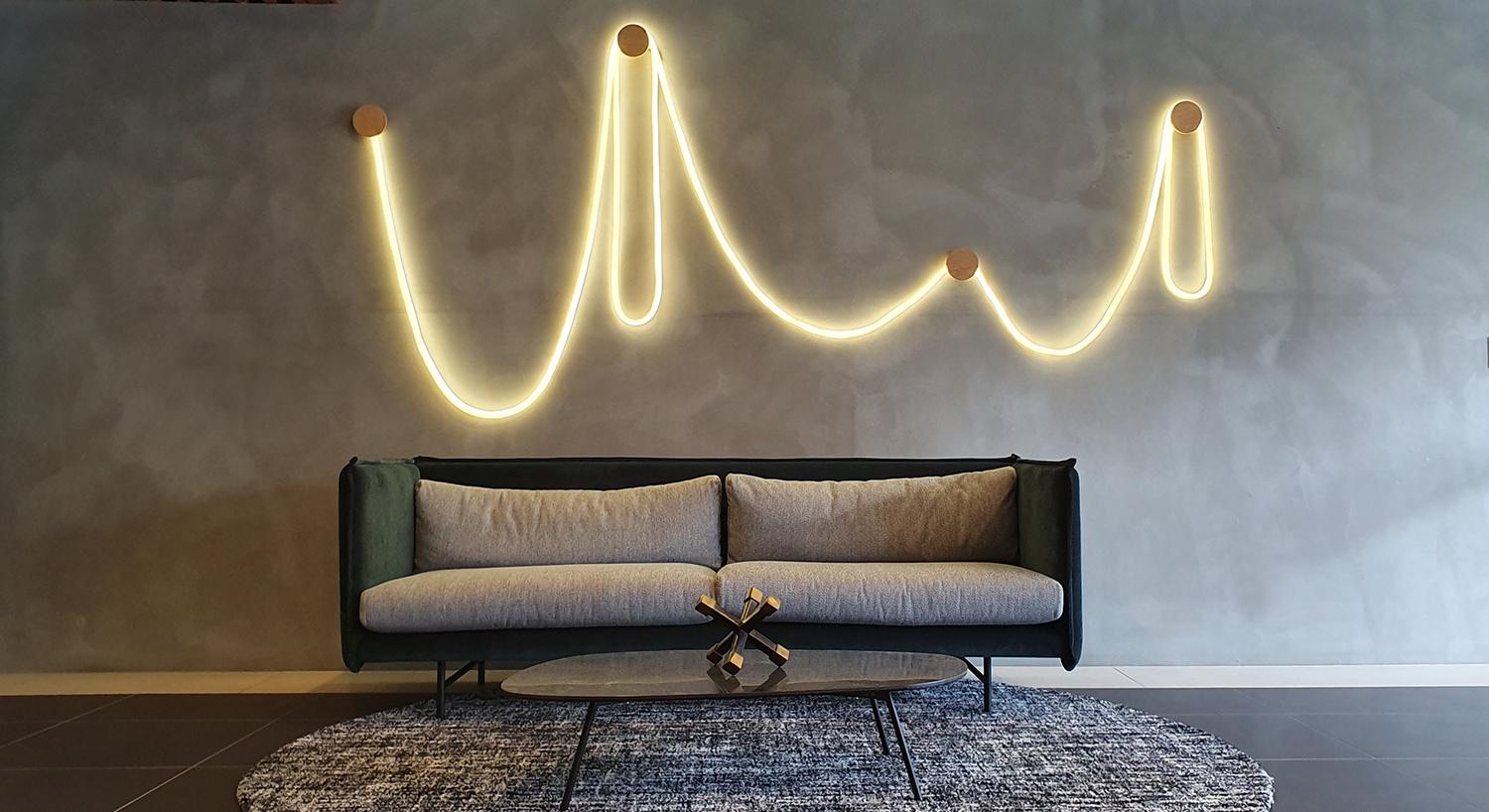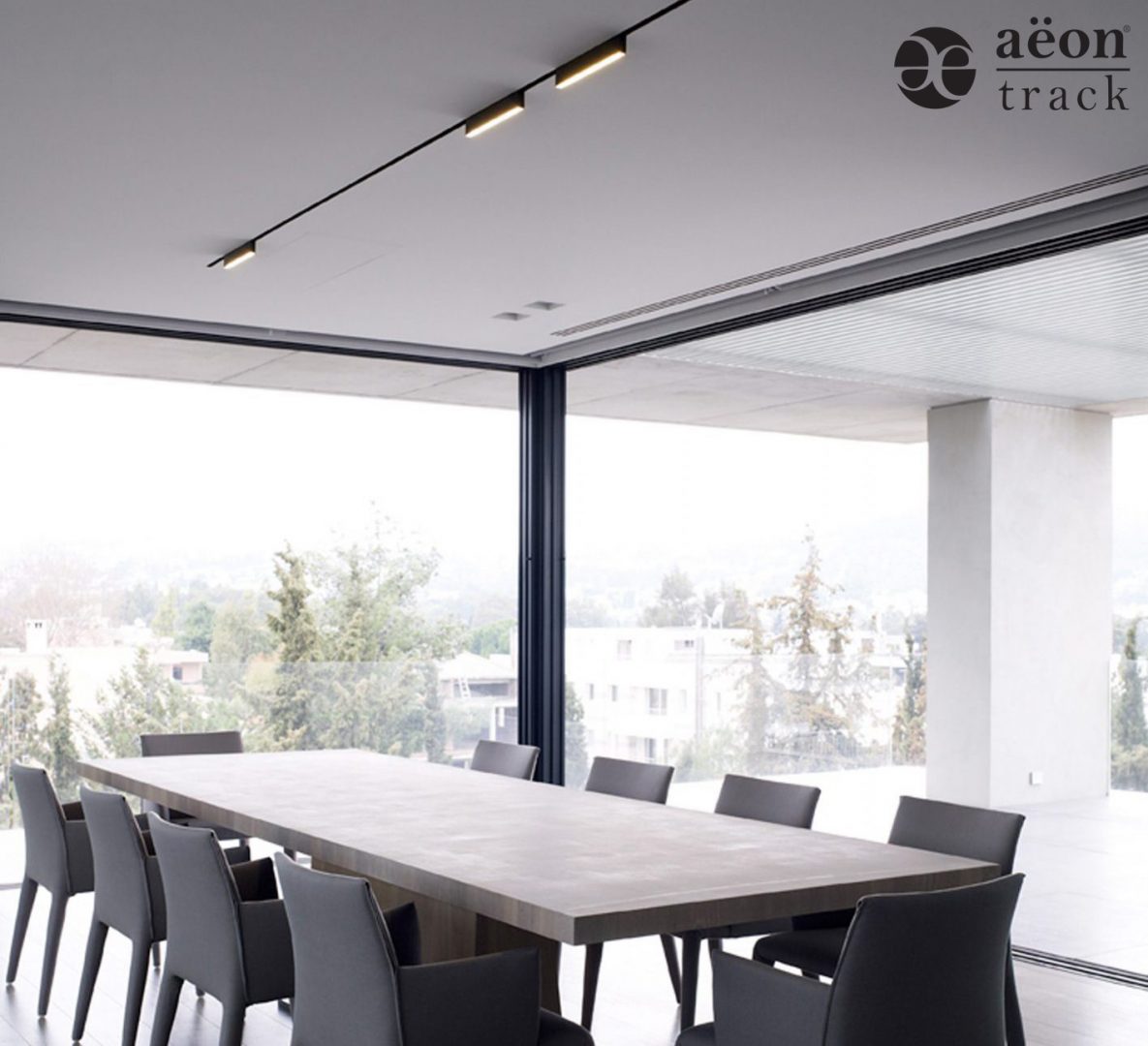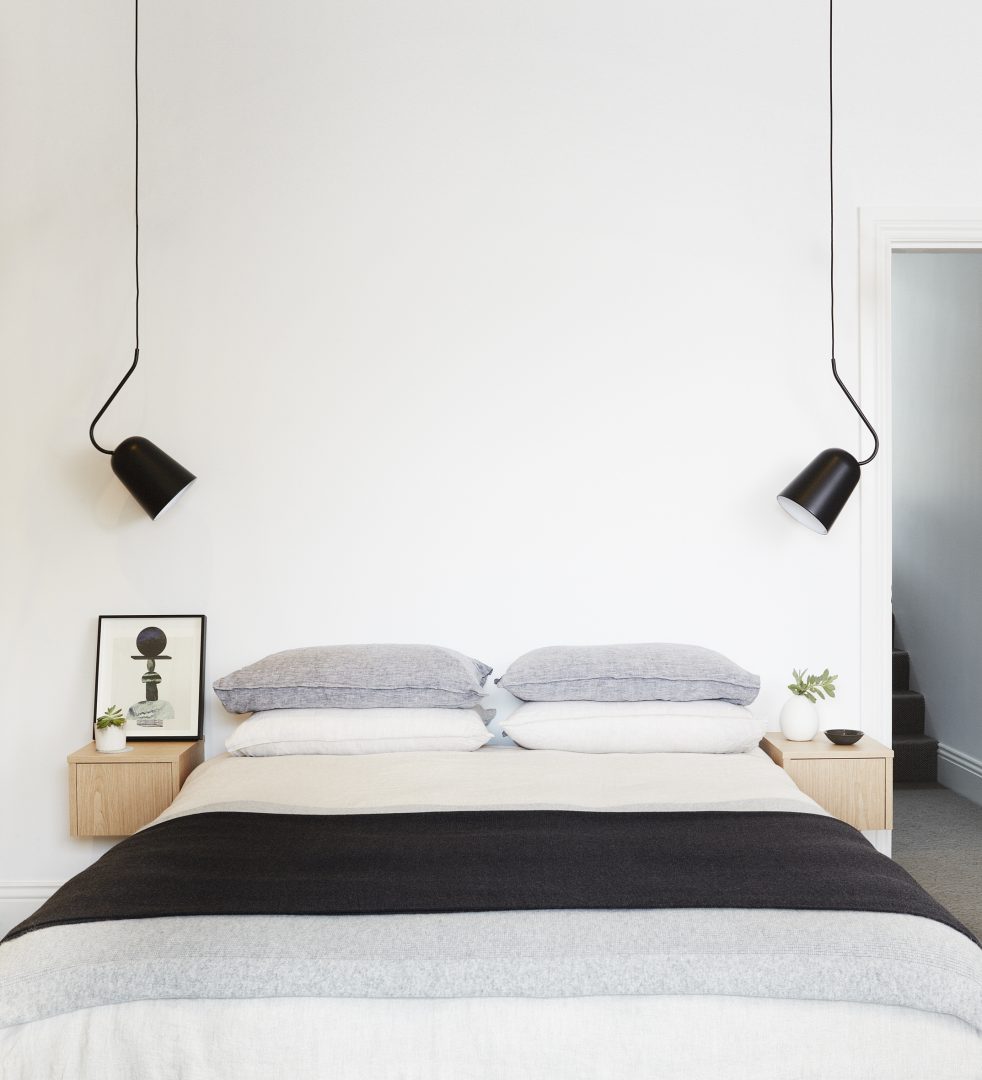2020 DARC Lighting Awards.
MELBOURNE, VIC, AUSTRALIA
Shortlisted for the 2020 DARC Awards; an international design competition for luminare design, Satelight submitted the GeoLux Grid lighting system. The system was designed to span an area of 12 meters x 9 meters and provide an omni directional light through the foyer of 350 Collins St, Melbourne
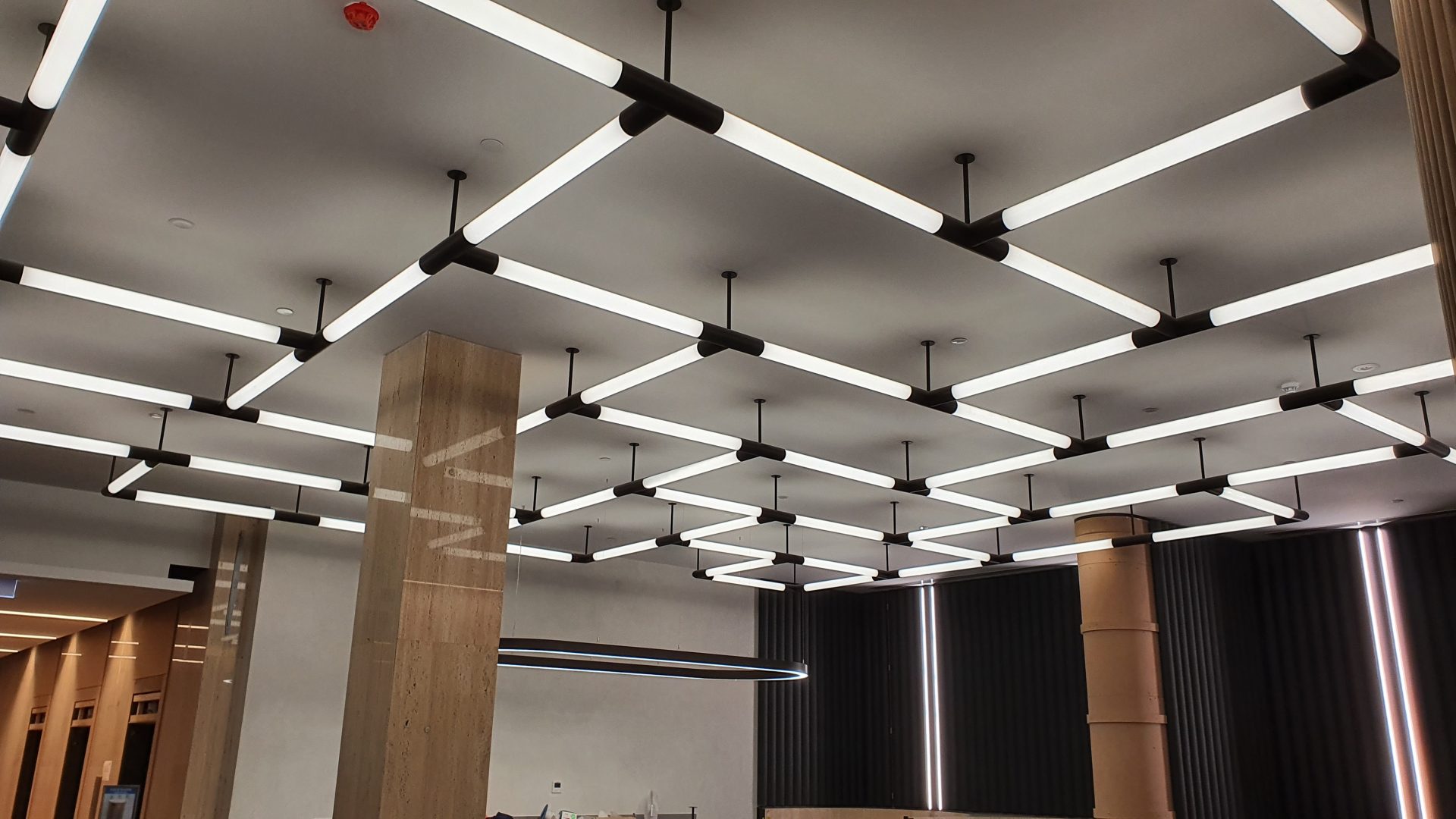
Constructed by using 4 basic components; straight, T connector, right angle and illuminated tube, they can be configured in various ways across a ceiling line. Using an innovative magnetic connector the new version is designed to allow for the illuminated tube to be removed and changed if it is cable suspended from the ceiling.
Satelight’s design philosophy of “think small to make it big” the fitting is designed to fit a small freight footprint. Once on site, the installers can easily install each piece at a time, rather than having to lift a massive installation into place, which in turn minimise equipment required on a busy work site.
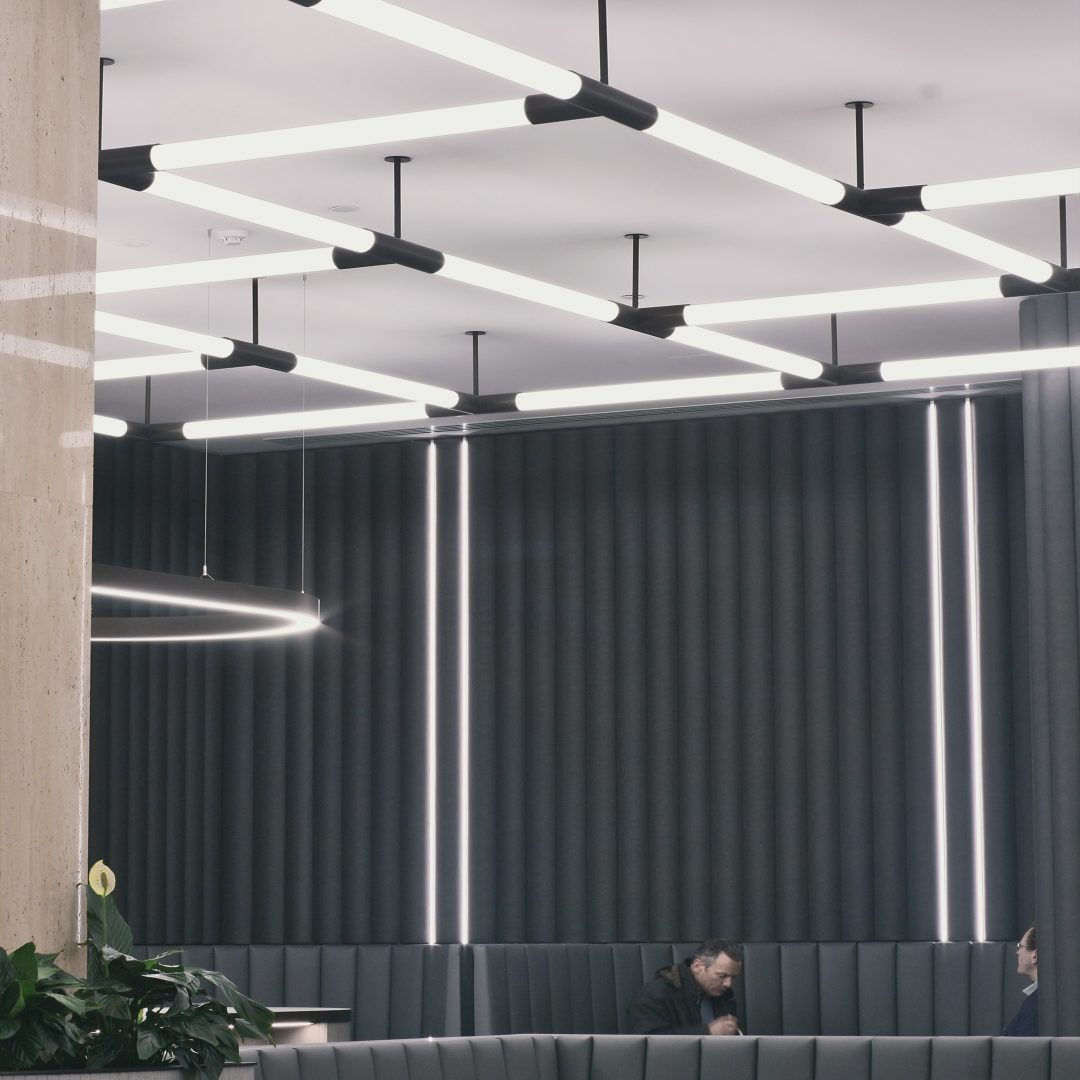
The custom installation was commissioned for installation in a building foyer at 350 Collins Street, Melbourne, Australia which was designed by Gray Pucksand Architects. The installation covered an area of 9 x 12 meters and required 86 illuminated tubes. Satelight also designed a customised feature wall as part of the installation. While GeoLux uses standardised sizes, Satelight can fabricated some custom elements as part of the concept.
PUBLISHED 22 April, 2021
PHOTOGRAPHY Satelight design
The Commons – South Yarra
MELBOURNE, VIC, AUSTRALIA
With the latest edition of the Commons Co-working space in South Yarra now open and operational, the beautifully detail space by Foolscap http://foolscapstudio.com.au/ design studio is a welcome haven after lockdown for anyone desperate to get out of their home office.
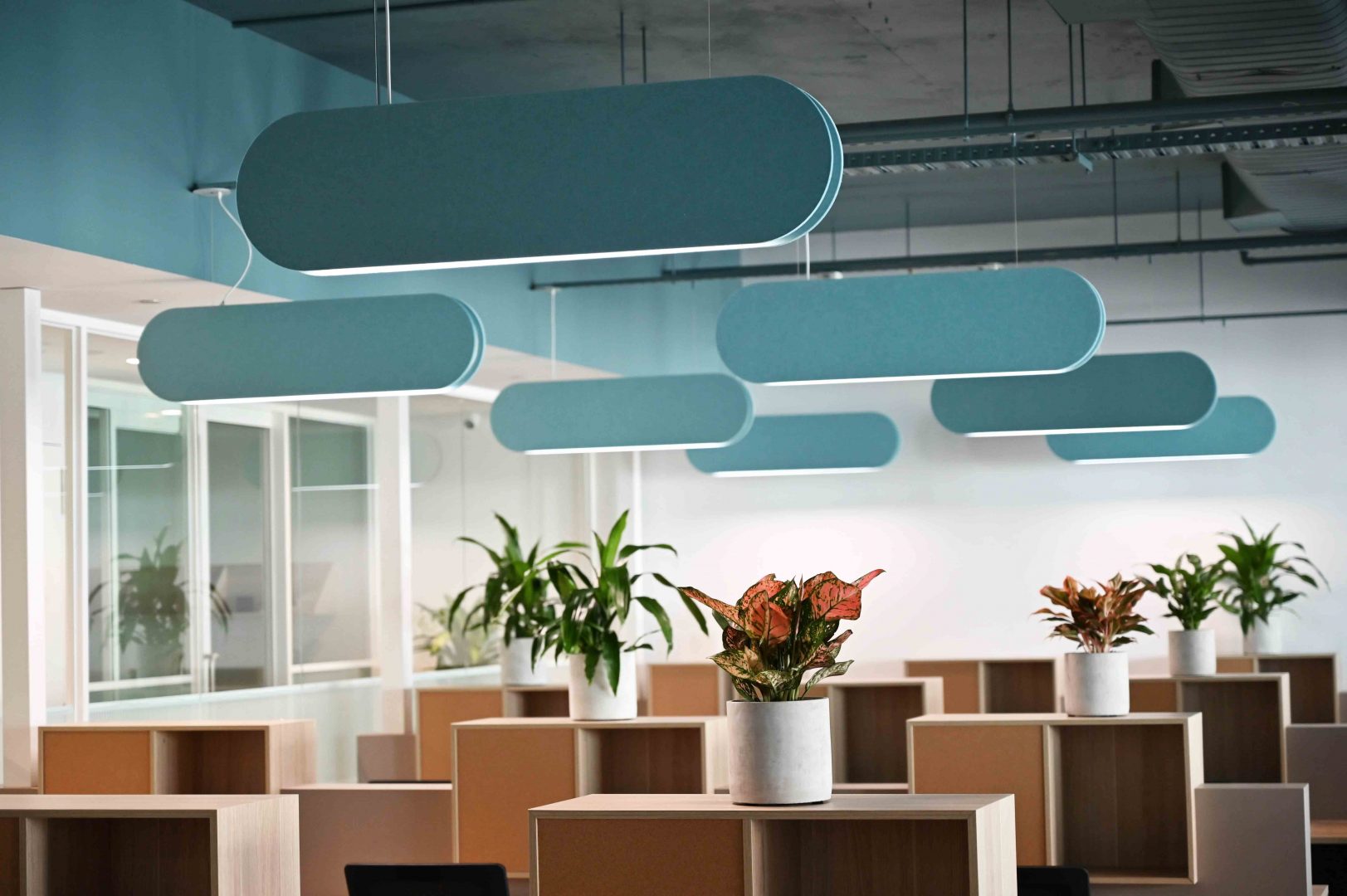
Spanning over three levels with numerous nooks to work away in, it is the perfect space to be able to do your best work and network with like minded people. Under the guidance of the team at Foolscap studio, Satelight customised the Reverb pill light fitting to suite the communal co-working areas with the Reverb Pill acoustic light fitting. The reverb was extended in length and designed to carry a high output light engine.
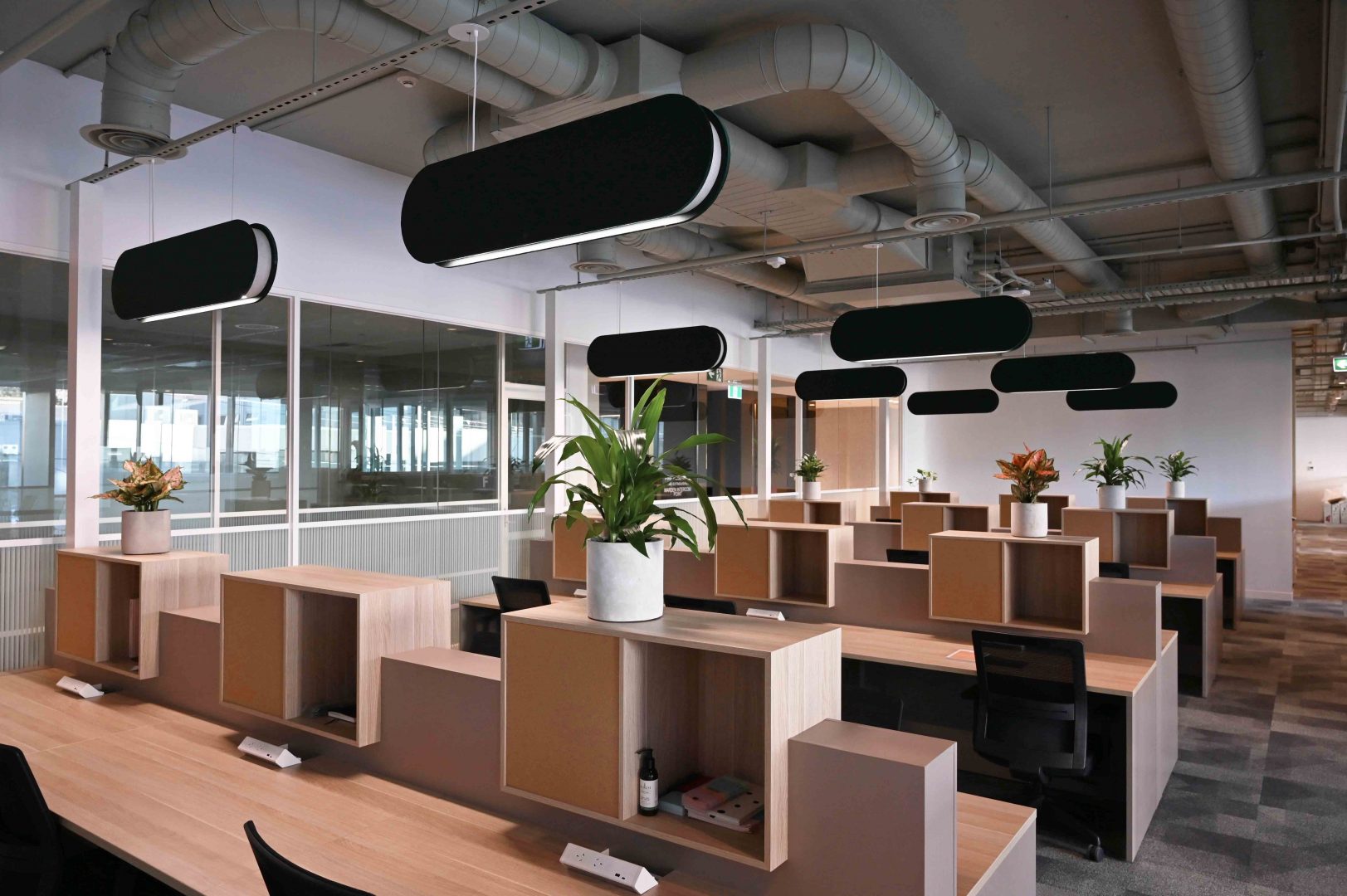
Reverb Pill pendant is manufactured using a dense felt panel which is acoustically rated to absorb different frequencies of sound. Joining the Reverb pill pendant light on this project were numerous other fittings like the Totem Duo pendant light and the Domo pendant for the entrance foyer.
Forming the integral lighting for the top floor cafe is a massive installation spanning some 50+ large spheres on a lighting track system. While it is a simple enough looking installation , it took many hours to finesse and get all of the parts in the right position. Located in the
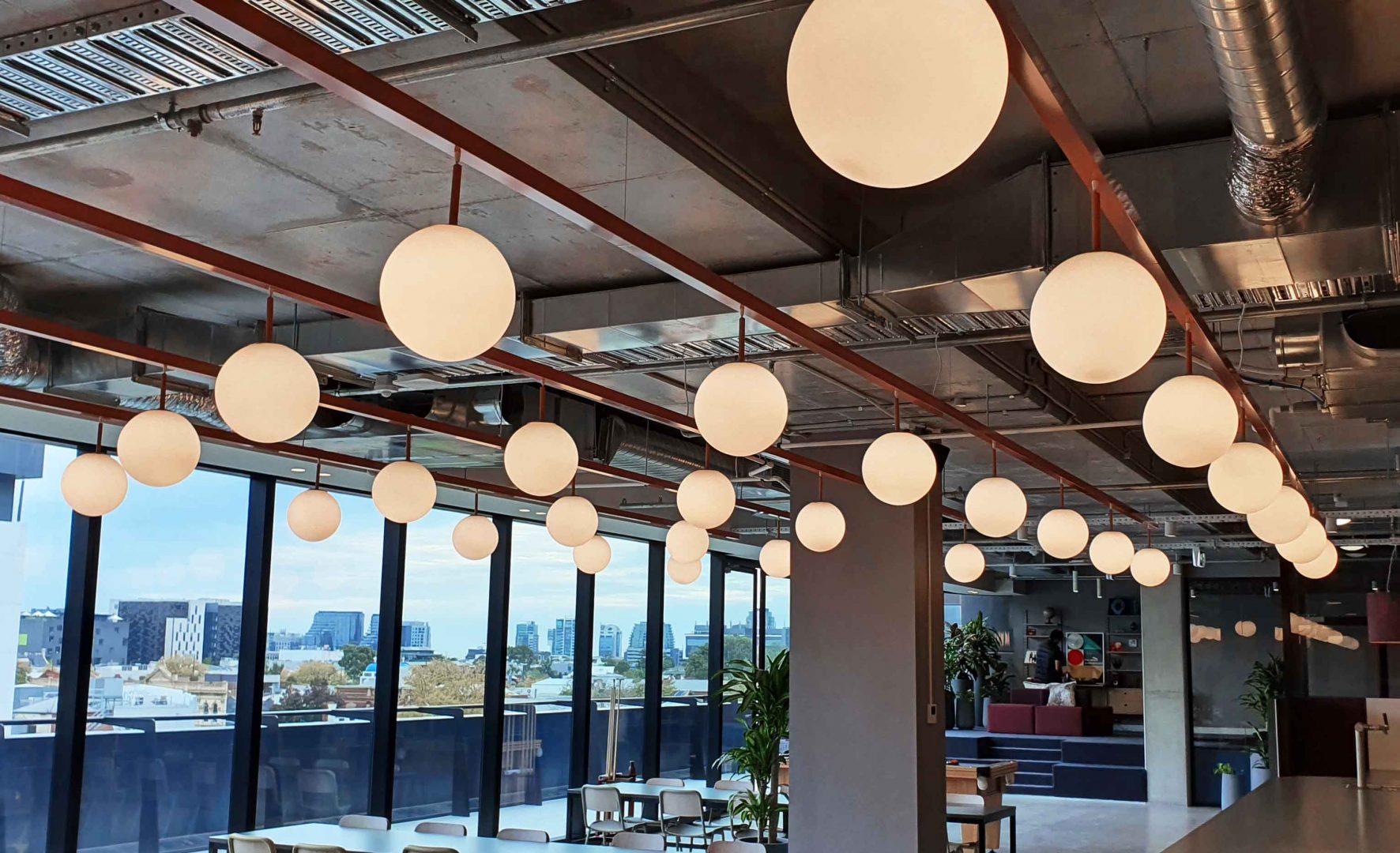
Not to detract from the simple elegance of the conference room, the space was illuminated by Satelight Circa pendant, which incorporated DALI dimmable light disks to control the light. A Massive thank-you to the team at Foolscap Studio for working with Satelight to help realize this project.
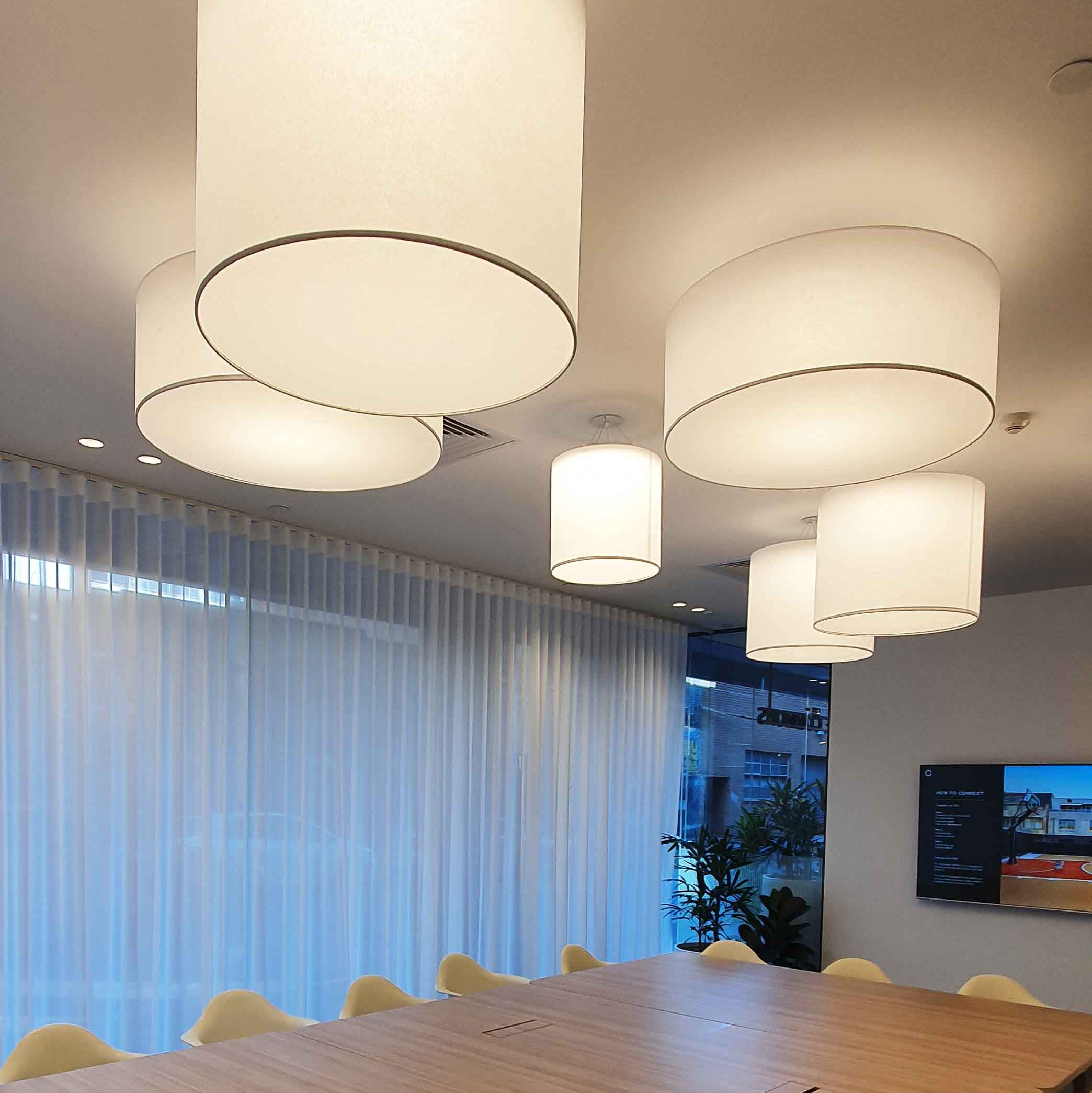
PUBLISHED 22 April, 2021
PHOTOGRAPHY DUNCAN WARD
Satelight Is an Aussie Design Studio Creating Elegant, Imaginative Lights That Turn Any Room Into a Tiny Gallery
MELBOURNE, VIC, AUSTRALIA
WORDS Georgina Safe
PHOTOGRAPHY Courtesy of Satelight
The pieces by Melbourne-based Satelight are designed to “become objects that the space wears”, ranging from delicate and whimsical to bold and geometric. The team is also making flat-pack desks that take just five minutes to assemble – no bolts or screws required.
“Light informs emotion, delights with colour and tells a story,” says Duncan Ward. “It’s a language – a conversation between the spaces it illuminates and the people that inhabit them.”
At his lighting design studio Satelight, Ward – along with designers Ben Merrylees and Matt McQuiggan – uses light to create atmosphere, invoke warmth and evoke feeling in spaces large and small.
Designed to “become objects that the space wears”, Satelight’s pieces can be as delicate and whimsical as the Entwine pendant light ($1775) – a brass rod with a glowing, woven rope suspended from it, looping around it, forming twists and knots – and as bold and geometrical as the Gatsby Flying V ($1200), a sleek, art-deco-inspired hanging LED light in a v-shaped timber fitting.
The team has also just launched the A-Line Design Desk, which arrives flat-packed, ready to be popped out of a single sheet of either fibreboard ($290) or plywood ($390). The desk takes just five minutes to assemble; requires no screws or bolts (instead, components slots into each other); and can be disassembled just as quickly.
Whether the team is turning its eye to practical home-office furniture or statement lighting, each piece is akin to a small art installation, designed with a technical and emotional lens. Works are inspired by everything from contemporary jewellery to the forms and textures of nature.
Satelight’s pieces are designed and manufactured locally in Melbourne, but the team has created works for clients in the United Arab Emirates, Canada, Europe and Southeast Asia.
There’s no online shop just yet, so you’ll need to get in touch for a quote. Prices start at $279 for a Hanging Garden Oval Pendant Light, up to around $4000 for custom designs.
Published on 16 June 2020 by GEORGINA SAFE via broadsheet.com.au
PHOTOGRAPHY Courtesy of Satelight
Support Australia Made
Satelight is a Melbourne, Australia based lighting design and manufacture studio. With over 20 years experience in designing and making, we are an accomplished team who are proud and extremely passionate about creating Australian made lighting.
With an in house lighting design team, we create our own range of light fittings as well as offering lighting customisation capabilities. Whether it be our own collection or custom installation, each light fitting we create is carefully crafted and resolved by our team of makers here in the Melbourne studio.
Now more than ever, it is important to support local makers in what ever field. At Satelight, we have a range of skills, equipment and technology that we utilise to create our lighting installations and fixtures. With the studio team all from a design background and the production team all specialising in different areas of lighting manufacture, we are more than capable of creating beautiful light fixtures. While we cannot do it all in house, we support our local manufacturing community by outsourcing specific skills to ensure our light fittings are created to the highest quality. For example we work alongside metalworkers, glassblowers and surface finishers to create our lighting collections.
By making light fittings locally, this offers an array of benefits to the Australian design and manufacture industry. Supporting local makers, such as Satelight, gives a high level of control to the designer over materials and processes. This not only means that the designer has a range of materials and processes to choose from, but they can also trust that the specified material and/or process will be achieved for their project. Likewise, we at Satelight utilise high quality materials and methods which also means ease of customisation for different project needs. By working with local makers like us, this also provides the beneficial opportunity for collaboration between the designer and the maker. By specifying Australian made rather than importing from overseas, this saves time through having shorter project lead times.
Supporting Australian made and local businesses such as Satelight, not only has a positive impact on the Australian design and manufacture industry, but also has beneficial impacts on the environment. When supporting local manufacture rather than importing from overseas, the fixtures have less distance to travel and therefore reduced carbon emissions. This also applies to the material that the light fitting is made from, whereby unique Australian materials can not only be utilised but celebrated through the light fitting.
As part of the Australian design and manufacture industry, we at Satelight are passionate about creating beautiful, functional light fittings for our industry. Within this industry, it is important to remember to support each other to assist the Australian economy as well as create aesthetic and practical spaces in which we as Australians inhabit.
Lighting Terminology
Ballast: A component required by fluorescent and HID lighting fixtures. It controls the voltage and electric current provided to the lamp during ignition and operation, preventing overheating or premature failure. Depending on their internal construction, ballasts can be either magnetic or electronic.
COLOUR TEMPERATURE (Kelvin): A hot object radiates a specific range of wavelengths that appear as a particular colour depending on the object’s temperature. The temperature is expressed in Kelvin (K), the scientific temperature unit. The Kelvin temperature equivalent is used to describe the lamp’s colour. Lamps generally vary from about 2500K, which is quite yellow through to 7000K, which is bluish.Standard lamp temperatures are 3000K Warm White, 4000K Neutral White, 5000K Cool White. Colour temperature can change how other surface colours look.
BC22 LAMP: a lamp with a bayonet base which is 22mm in Diam
E27 LAMP: a Lamp with a screw in base which is 27mm Diam.
Ceiling Cavity: The portion of a room that is above the lighting fixtures.
Color Rendering Index (CRI): A metric used to describe how faithfully a light source can render the true colors of objects and spaces, where natural light sources like the sun have a perfect index of 100. Using lamps with a CRI of 80 is good for general illumination CRI 90 is good for colour critical spaces such as galleries
DALI : Acronym for Digitally Addressable Lighting Interface, a communication protocol for lighting automation, which enables individual dimming of individual luminaries
Driver: Piece of electronic equipment that transforms the main supply voltage into a lower DC voltage that is appropriate for LED lighting. Some LED lamps have a built-in driver, while others require one to be connected externally, just like the ballasts used by fluorescent and HID lamps.
Electronic Ballast: A subtype of ballast that uses power electronics to provide a high-frequency voltage and controlled current for fluorescent lamps. Electronic ballasts are lighter and more efficient than magnetic ballasts, and they eliminate humming and flickering issues.
Electronic Transformer: Smaller and lighter than magnetic transformers, electronic versions use electronic switching and special dimmers to step the line voltage down to the lamp voltage.
Glare: Visual impairment caused by a bright source of light, directly visible or reflected by a surface. There are two types of glare:
1: Discomfort glare causes an instinctive reaction to close the eyes and look away. This is the type of glare felt when exposed to a potent HID light or when the sun is directly visible through a window.
2: Disability glare impairs vision, but does not cause the same reaction as discomfort glare. If a light source gets reflected on your laptop screen, for example, it does not bother your eyes but distinguishing objects on the screen may be impossible.
Halogen Lamp: An improved version of incandescent lamps, where the glowing filament is contained in halogen gas, hence its name. Halogen lamps are around 25% more efficient than their incandescent counterparts.
Illuminance: The luminous flux on a surface, per unit of area. The illuminance requirements of built environments are determined by their intended purpose, and there are two common units of measurement:
Incandescence: Light produced by heating a material; Examples include the glow of a candle, an incandescent filament lamp, a shooting star, etc.
Kelvin (K) Measurement unit for temperature, although in the lighting industry it is more commonly used to indicate the correlated color temperature (CCT) of light sources.
Lamp Lumen Depreciation (LLD): A progressive reduction in the luminous output of a lamp throughout it service life.
LED: Acronym for light-emitting diode, a solid-state component that emits light when exposed to electric current. LED lighting represents the state-of-the-art in the industry, outclassing most other types of lighting in terms of energy efficiency, design flexibility and colors of light available.
Light Engine: describes the actual source of illumination, whether it is LED or incandescent lighting
LUMINOUS INTENSITY (Candela) Luminous intensity is a measurement the light radiating from the lamp in a particular direction, disregarding the intensity of light in other directions. The Candela figures for a source need to be given for specific directions but are independent of distance from the lamp. Manufacturers provide charts showing the luminous intensity of a lamp in every direction from the source. These charts can be used to calculate the total luminous flux and the illumination intensity surrounding the lamp.
LUMINOUS FLUX (Lumens) The perceived total amount of useful light from a source is the sum of the Candela measurements in all directions. It is measured in Lumens (lm). The figure is also independent of distance from the lamp and says nothing of the direction of the light, the intensity of the source or the brightness of an illuminated surface, just the total visible light in all directions.
Lumen: Measurement unit for the lighting output of lamps or fixtures. The total lumens emitted and their spatial distribution are of paramount importance when creating appealing and luxurious indoor spaces. In lighting, lumens can be compared to miles traveled and watts can be compared to fuel consumption.
Luminaire: A complete and functional lighting fixture. A luminaire includes the lamp, the ballast or driver, internal wiring, reflectors, lens and any additional components required to deliver light.
Mounting Height: Depending on the application, mounting height can have two possible definitions:
1: Distance between the bottom of the fixture and the work plane. 2: Distance between the bottom of the fixture and the ground.
OLED: Acronym for organic light-emitting diodes, flexible polymers based on organic carbon molecules, where the light source is spread across a surface as opposed to a point source.
Pendant Light / Pendant Fixture / Pendant Lamp: A lighting fixture that is designed to hang from the ceiling, and which often uses a shade to prevent glare. Pendant lights can be used for both general and task lighting.
Task Lighting: Lighting fixtures with the goal to improve visibility in an area where specific tasks will be carried out, hence their name. The use of under cabinet lights for food preparation areas in kitchens is an example of task lighting.
Universal dimming: refers to the method in which a lamp can by dimmed using both leading and trailing edge control. Universal dimmers tend to operate better with electronic transformers for AC LED lamps.
Voltage: The electric potential difference between two contacts. Voltage drives electric current through lighting fixtures and other appliances, just like pressure drives the flow of water in plumbing installations.
Watts to Lumens: To convert watts to lumens, multiply the power (P) in watts (W) with the luminous efficacy (η) in lumens per watt (lm/W).
Language of Light – The Entwine Collection by Satelight Design
MELBOURNE, VIC, AUSTRALIA
WORDS James Lyall Smith
PHOTOGRAPHY Duncan Ward & Gallant Lee
Entwine is the latest collection by Melbourne based lighting design and manufacturing studio Satelight. Comprising of the Entwine pendant, Unwind wall and ceiling light, and the String Theory wall light, Entwine is a narrative that takes shape within the coils of the rope and tells the story of a journey in light.
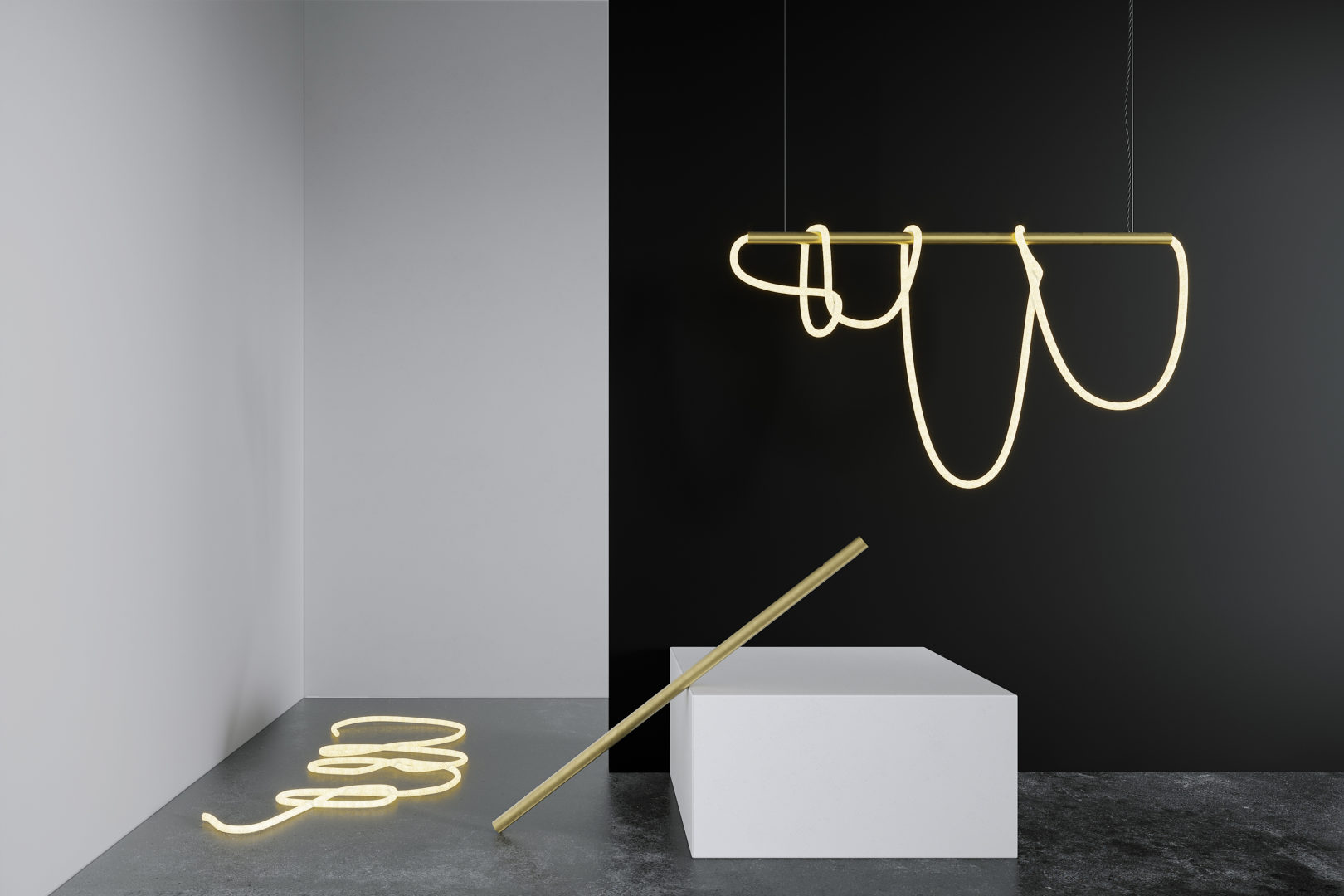
Designed and created by Duncan Ward and Ben Merrylees for Satelight Design, the various interweaving paths and connections make the Entwine Collection part lighting fixture and part sculptural statement. “I envisioned the Entwine lighting pieces as beautiful jewellery adorning spaces,” states Satelight Design Director Duncan Ward. “My ultimate vision is for the lighting to reflect the unique personality of each space whilst incorporating the lives of the design with each individual user.” Fusing woven rope, brass and timber together, the highly customisable collection can be used to create lighting installations in both residential and commercial projects.
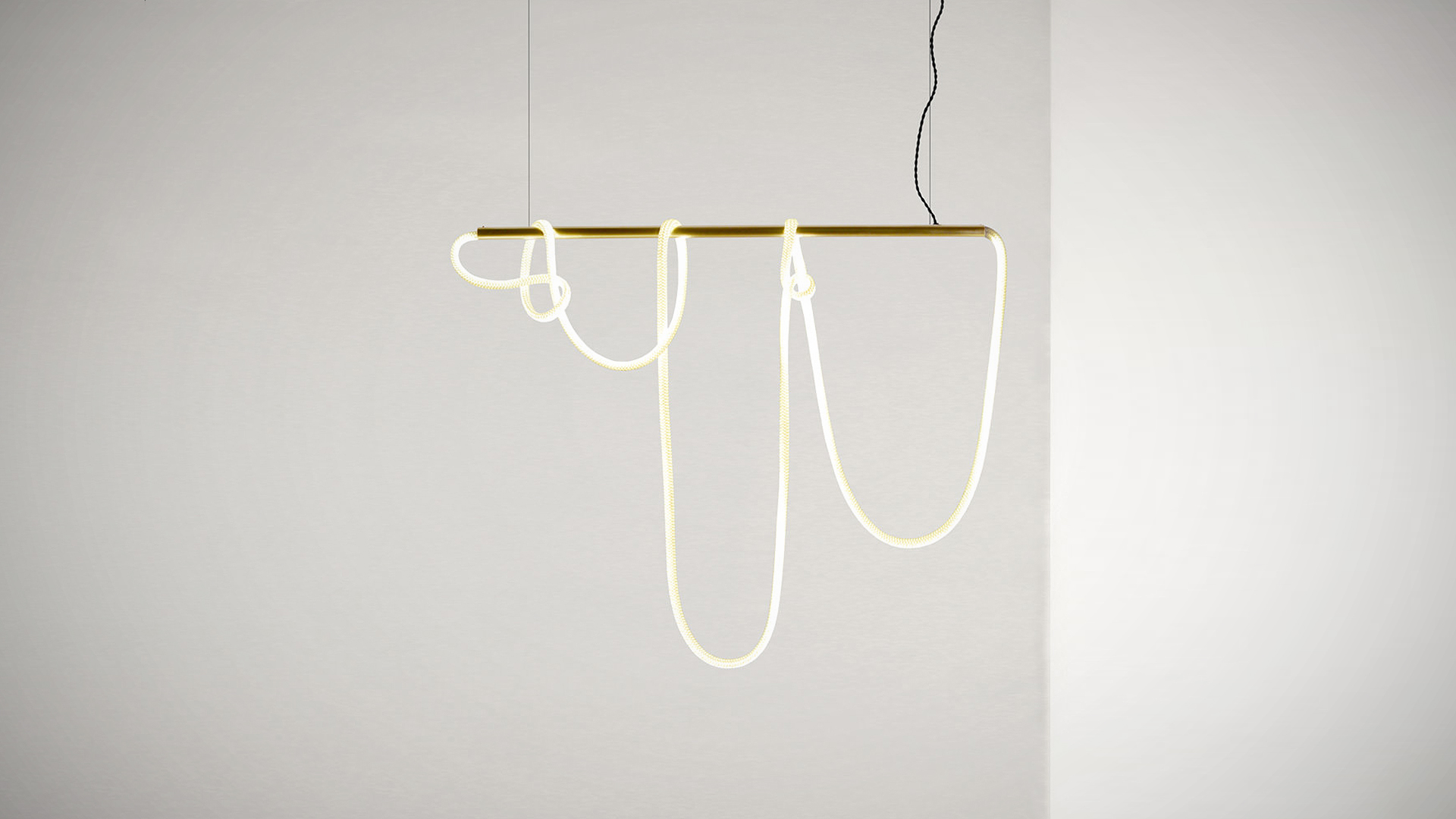
Designed and created by Duncan Ward and Ben Merrylees for Satelight Design, the various interweaving paths and connections make the Entwine Collection part lighting fixture and part sculptural statement.
Entwine builds on Satelight’s strong connection to local design and manufacturing, as well as their impressive reputation for the creation of custom designer lighting. “At Satelight we work with local craftspeople and artisans whilst creating a strong connection to the Victorian arts community,” explains Duncan. “We want the Entwine Collection to truly express our creativity whilst using innovative installation techniques to develop a completely new language of light.”
“My ultimate vision is for the lighting to reflect the unique personality of each space whilst incorporating the lives of the design with each individual user.”
Aware of the critical importance of lighting to any space, Satelight has used the Entwine collection to deliver new stories around lighting design and technology. Through the creation of movement in the coils of light, the Entwine collection cultivates a dramatic sense of emotion for a residential or commercial space. “We want to create lighting elements that the user can interact with,” states Duncan. “Given the inherent durability of the woven material and the use of Ip 65 rated LED strip, we envisage the collection having capabilities in numerous environments.”
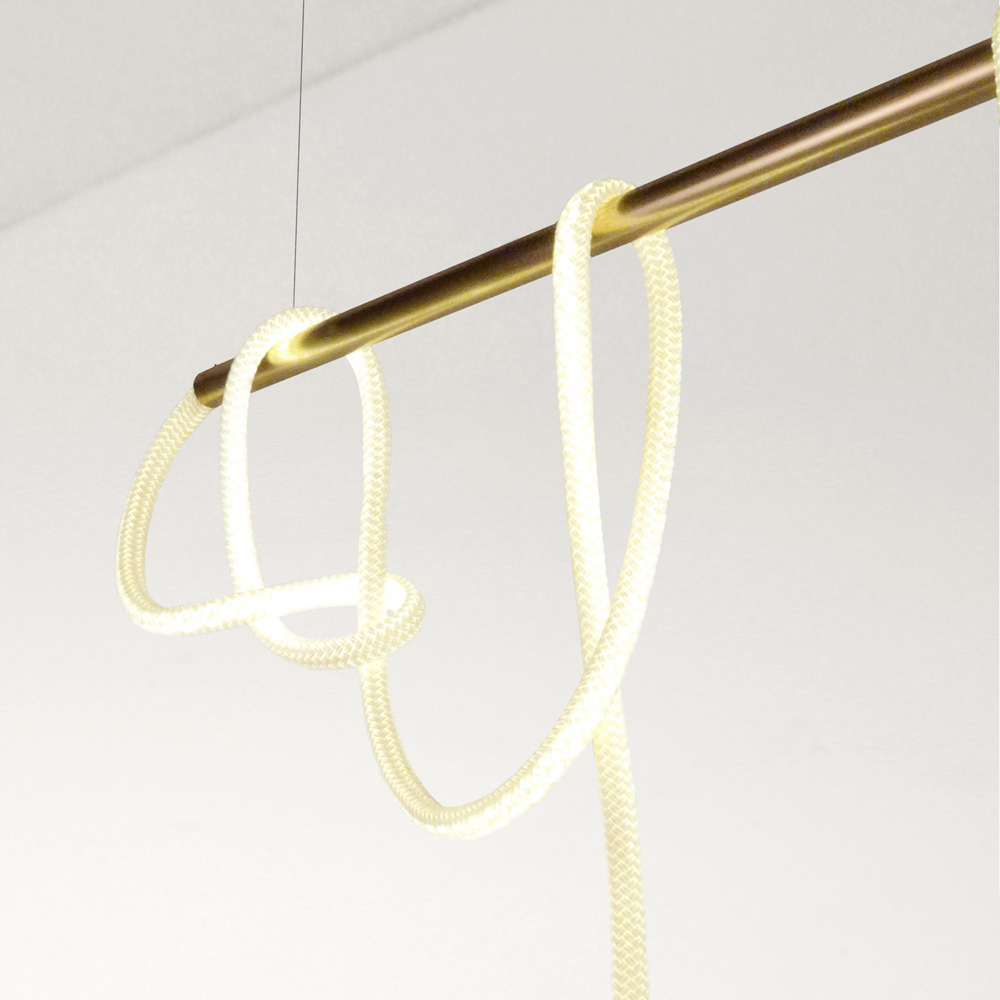
The Entwine collection is comprised of customisable statement pieces that utilise creative design and innovative technology to establish sculptural lighting fixtures that are designed to be worn like jewellery within a space. Whilst telling the story of a journey in light, the Entwine also represents the quest of Duncan Ward and Ben Merrylees to establish a new language around lighting installations, in the process reaffirming Satelight’s commitment to local design and manufacturing.
The Entwine collection is comprised of customisable statement pieces that utilise creative design and innovative technology to establish sculptural lighting fixtures that are designed to be worn like jewellery within a space.
PUBLISHED 13 FEBRUARY, 2020 via thelocalproject.com.au
PHOTOGRAPHY DUNCAN WARD & GALLANT LEE
Anatomy of a Light
There are many components and considerations that are important in understanding the anatomy of a light and therefore the effect light has on the anatomy of the space. Having an understanding of the components that make up a light is essential in achieving the right mood for the space as well as ensuring the space functions effectively for the end user. Understanding the technical anatomy of a light such as the lighting interface, wiring and LED drivers assists in creating a well functioning space. In addition, understanding the aesthetic anatomy of a light such as mounting, ceiling canopies and the light source assists in creating the right mood and aesthetic for the space.
Interface:
The lighting interface can vary significantly between different types of light sources. Consideration at the beginning of the project needs to be made into who needs to control the lighting onsite and what level of control is required over the lighting. For example, there are some situations when you would want to restrict access to lighting controls such as childcare, aged care, public spaces and retail environments.
Wiring:
Typically electrical wiring for light fittings will either be 3-core or 5-core depending on the light source. Most standard ES lampholders run off 240 volt, which requires 3-core wiring including 2 power cables and one earth cable. If a product has been wired using 3-core it can be difficult to later retrofit a digital dimming system. Whereas most LED light sources run off 12 or 24 volt, which requires 5-core wiring including 2 power cables, 1 earth cable and 2 data cables. In 5-core systems, data is passed in both directions which allows for information to flow from the interface to the light fitting and vice versa.
LED Driver:
An LED driver is required to regulate power to an LED light fitting. LED drivers can be non-dimmable or dimmable, typically dimmable drivers run on DALI, DSI or Switch DIM systems. It is common for LED drivers to be located in the ceiling cavity, however they can also be located on the light fitting itself as well as remote mounted in track lighting systems. It is important to be aware of the distance between the driver and the light source, because if there is more than 3m distance between the driver and the light source there is a risk of electromagnetic interference with the data signal. If you want your lighting system to work with digital dimming systems then you need the following:
– Interface that can control dimming levels and is compatible with your chosen dimming system.
– 5 core wiring
– Dimmable light source
– Dimmable driver if the light source is LED
Mounting:
Light fittings can be mounted to the ceiling or wall surface in many different ways. Typically light fittings are usually suspended or surface mounted, however with pre-planning recessed lighting solutions can be implemented.
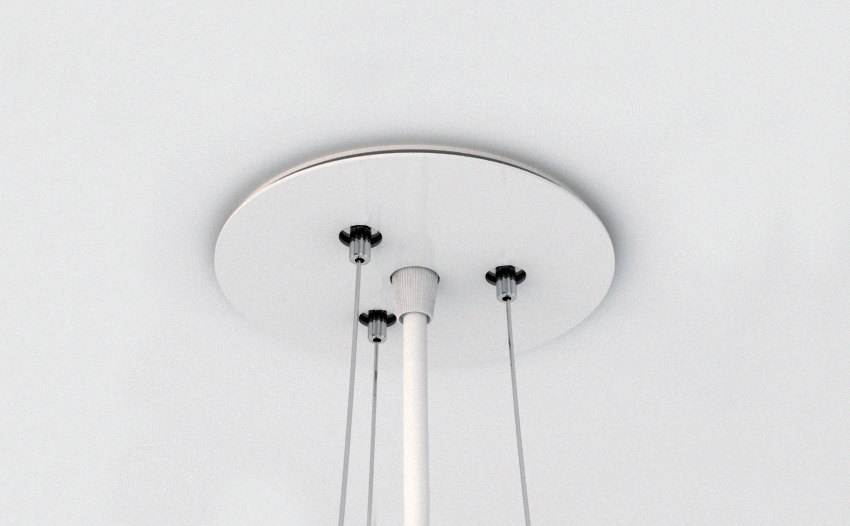
Ceiling Canopy:
The ceiling canopy is an integral component within light fittings. As standard, all suspended Satelight light fittings are supplied with a low-profile ceiling canopy. The ceiling canopy disguises the fixing points as well as connects the power cable from the driver/mains power to the light fitting itself. Although dependant on the light fitting, ceiling canopies can provide a central hub for suspension cables to be connected to the ceiling. Ceiling pucks can be used in addition to a ceiling canopy if the fitting is suspended close to the ceiling or the fitting is of large scale. Satelight’s low profile ceiling canopies are supplied in a white powdercoat finish, which on a standard plasterboard ceiling is unobtrusive and blends into the ceiling seamlessly.
Light Source:
There are many different types of light sources for different light fittings. Light sources can include; bulbs, LED disks, LED strips, fluorescent tubes and more. Of these light sources only some are digitally dimmable. For example LED light sources are digitally dimmable which provide benefits in using a lighting interface. Other benefits of LED light sources include; low heat output, low power consumption, low running costs, long lifespan, technical abilities (CRI etc.) and choice of colour temperature. However not all types of light sources are digital dimmable. For example, light fittings that are fitted with ES lampholders for light bulbs are only dimmable on a pot-dimmer switch and can be difficult to retrofit in order to work on a digital dimming system. Likewise, ES lamps tend to have a much shorter lifespan as well as a lower energy efficiency in comparison to LED’s.
Understanding the technical and aesthetic anatomy of a light assists in creating the anatomy of the space that you are designing for. Having knowledge on lighting interfaces, drivers and wiring gives you the groundwork in creating a functional space. Having knowledge on mounting systems and light sources gives you the ability to create an aesthetically pleasing space. In conjunction both of these work together to achieve functional and aesthetic spaces.
Planting For Projects
Continuing the efforts to help our environment.
While we are not a big business, we realise that we can all have an impact to improve the environment. As a team we have discussed ways in which we can help and have decided that our goal for 2020 is to plant 5000 native trees around Australia. For each project we will be donating 15 trees to help reforest and restore local environments.

We acknowledge that whenever we create it uses resources, and as this has an impact on our environment, we need to be proactive to improve what we do. Over the past few years we have been working on methods to improve how we make and pack our products. We are now wrapping our fittings in biodegradable plastics and unbleached paper. Using sustainably grown timbers, designing fittings that can be disassembled at the end of life and incorporating low energy consuming LED light engines.
In the coming months we will be sharing a list of suppliers who offer environmentally friendly packaging and materials. Alongside this, we want to ask you to share with us your knowledge to help us improve what we do.
Satelight Team

Apartment Lighting
Seen one apartment, seen them all, right!! …wrong.
When it comes to apartments often it feels like you have seen it all before. Generally in the design of their apartment projects, developers take a cookie cutter approach. A simple copy and paste strategy to save time and money, which can result in dull and displeasing living environments.
Whereas a more livable apartment is more appealing to the developer, client and end user. To create this bright and enjoyable living environment, the difference is in the finer details of light. These details can first be identified in understanding the building envelope, which includes knowing how the apartment is constructed and what the apartment includes.
So let’s start with how the space is constructed, typically standard apartment ceiling heights are just 2.4-2.8 meters. These minimal ceiling heights limit the type of lighting suitable for the apartment. Another major consideration is the depth of the ceiling cavity and the ability to penetrate the ceiling in areas other than where the downlights, exhausts or heaters are installed. Likewise, building fire regulations are a huge consideration that needs to be made as this can limit what lighting can be used and where holes can be made in the ceiling structure. Lastly, confirming if the apartment wiring has dimming capabilities and which dimming system it utilises is essential in specifying the right light for the right space within the apartment.
When it comes to what the apartment includes, consideration needs to be made into the various areas within the apartment. This includes bedrooms, kitchen and lounge areas. Which all have differing purposes and requirements to create a livable and saleable apartment, for both the end user and the developer.
Starting with the bedroom, light is a secondary function to the room. The main function is to provide a space to sleep, but within smaller apartment living bedrooms need to provide flexibility of use and therefore adaptable lighting. A typical apartment bedroom would include an oyster, downlights and a bedside table lamp. However, oysters and downlights flatten the environment and table lamps take up usable space. As an alternative, a directional pendant hung low over the bedside table looks contemporary and takes up no usable space. In addition, a mirror with side illuminating LED’s or ambient lighting behind the bedhead creates a more moody, intriguing space. Minimising the amount of downlights and adding ambient lighting creates a more livable, relaxing bedroom within the apartment.
When it comes to the kitchen of an apartment, task lighting is often utilised as functional light source but also a contemporary look. Due to low ceiling heights within apartments, low profile linear task lighting is an effective option. These have the ability to act as a task light, can be dimmed for ambience and are unobtrusive when standing at a kitchen bench. Additionally, upward and downward illumination creates more volume within these spaces.
Likewise, track lighting systems are an effective light source for kitchens as they have benefits in regards to minimal use of space and flexibility of use. There are multiple types of track configurations to suit your specific apartment space such as recessed track, surface mounted or suspended. Recessed track lighting systems create a clean surface along the ceiling, however this requires careful planning ahead of time to avoid hidden ceiling structures. Whereas surface mounted track lighting systems work well for lower ceiling heights, or suspended track systems can work for higher ceiling drops. Track lighting can also have multiple light dimming channels along the one length of track, which gives the user the ability to create mood and control the lighting levels for their specific task. One of the other great benefits in using a track system is that the fixtures contain the LED light driver in the unit, which means they don’t have to be hidden in the ceiling.
Having light at different levels is important, particularly for short ceiling heights. Within apartment kitchens, overhead cabinets provide the opportunity for ambient LED strip or point lights to light the preparation area. When it comes to LED’s though, it is important to keep in mind the colour temperature that is comfortable and functional for each different area within an apartment space. For example, within a kitchen a warm white of 3000K feels comfortable, but can make food look more yellow. Whereas a neutral white of 4000K gives better colour rendition and does not feel harsh or too cool.
Lastly, when it comes to the lounge and living areas the lighting greatly affects the livability of these spaces. Within lounge areas, the location of the television is important in avoiding glare and being at a comfortable position to watch. The television is also a light source in itself and at night it will create a glare on the window. If possible, put the television in a cove or a cupboard, this can assist in eliminating direct light onto the surface of the screen. This also provides the ability to conceal the television when entertaining and take advantage of the window views. Likewise, maximising the window location is essential in creating a flood of natural light. Daylight is a free resource that should be harnessed to its full potential, and is proven to create a more inviting, comfortable environment to live in. However, it is necessary to invest in proper window screening such as sheer or block-out blinds, which provide a sense of privacy as well as control over heat, glare and illumination levels at various times of the day.
Throughout the living spaces within an apartment it is integral to give these spaces volume and ambience. In hallways this can be achieved through wall lights, which bounce light off the walls. In living spaces, a low floor lamp can also help create height by making the eye move from the floor to the ceiling. Having light at different levels within these spaces creates volume and ambience, making living spaces appear larger and more inviting.
In summary, being able to work the light is such a critical factor in how you use and feel within an apartment space. Without light we cannot see and with the wrong light we notice the imperfections within the space. But with the right light the space tells the story it was intended to tell.
Duncan Ward – Associate IES-BA
Director – Satelight design Pty Ltd
Heading
Custom lighting
Lorem ipsum dolor sit amet, consectetur adipiscing elit, sed do eiusmod tempor incididunt ut labore et dolore magna aliqua. Ut enim ad minim veniam, quis nostrud exercitation ullamco laboris nisi ut aliquip ex ea commodo consequat. Duis aute irure dolor in reprehenderit in voluptate velit esse cillum dolore eu fugiat nulla pariatur. Excepteur sint occaecat cupidatat non proident, sunt in culpa qui officia deserunt mollit anim id est laborum.
- one
- two
- three
- four
Lorem ipsum dolor sit amet, consectetur adipiscing elit, sed do eiusmod tempor incididunt ut labore et dolore magna aliqua. Ut enim ad minim veniam, quis nostrud exercitation ullamco laboris nisi ut aliquip ex ea commodo consequat. Duis aute irure dolor in reprehenderit in voluptate velit esse cillum dolore eu fugiat nulla pariatur. Excepteur sint occaecat cupidatat non proident, sunt in culpa qui officia deserunt mollit anim id est laborum.
For frodo
Aragon

